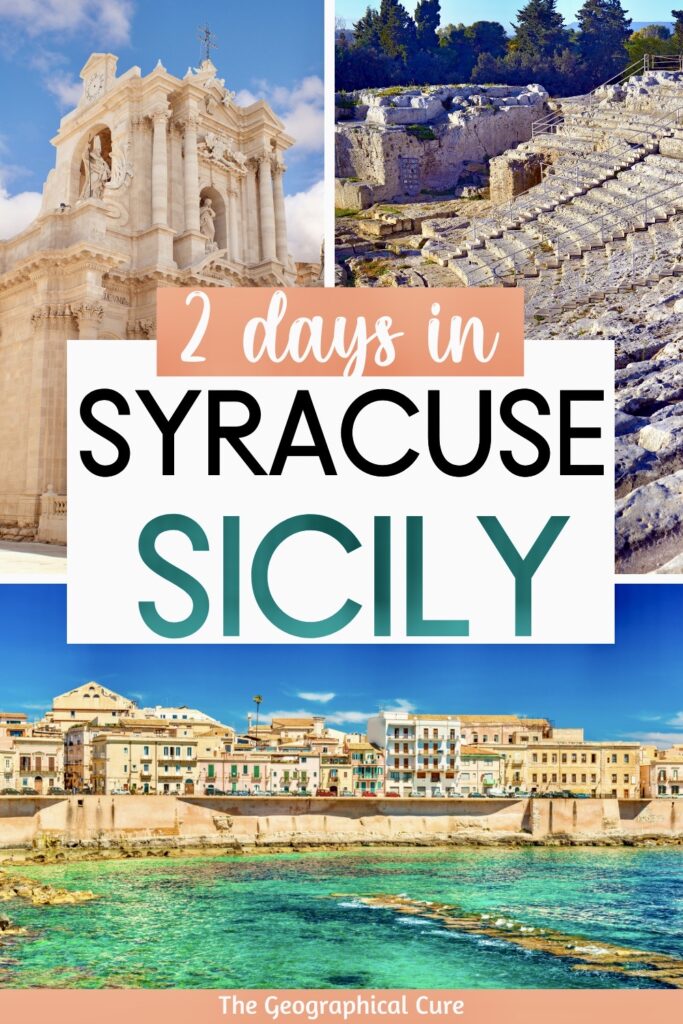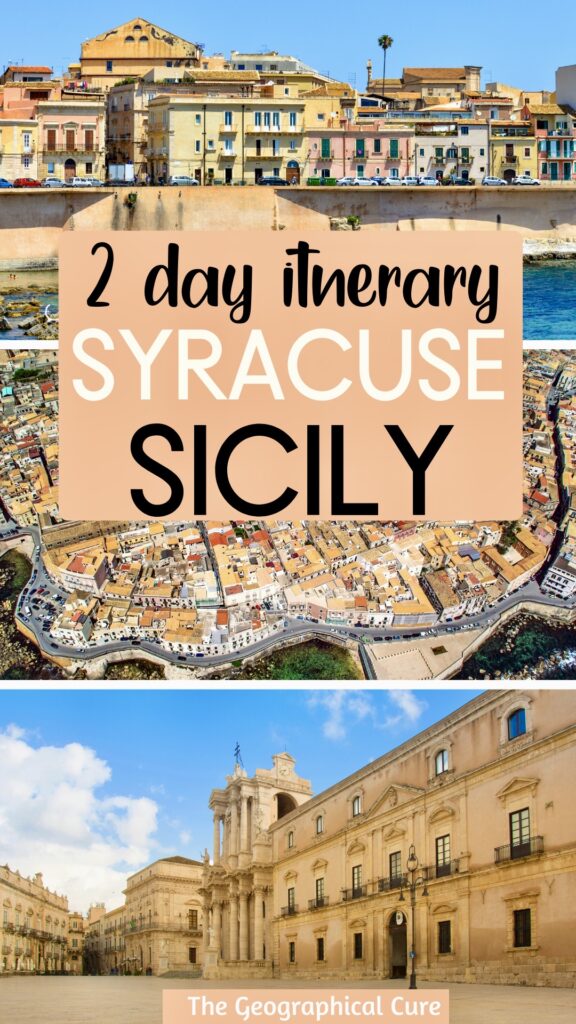Syracuse is a wondrous ancient city in southeast Sicily. There is no shortage of things to do in Syracuse, making it the perfect place to spend 2 days.
Founded by the Greeks in 734 B.C., Syracuse has breathtaking architecture and archaeological sites that span centuries. At the the city’s zenith, it rivaled Athens in power and glory. Cicero called Siracusa the “greatest and most beautiful of all Grecian cities.”
Syracuse is divided into two parts, the new city (Neapolis) and the island of Ortigia, the beautiful historic heart of the town. Some people think they’re different entities. But they’re not.
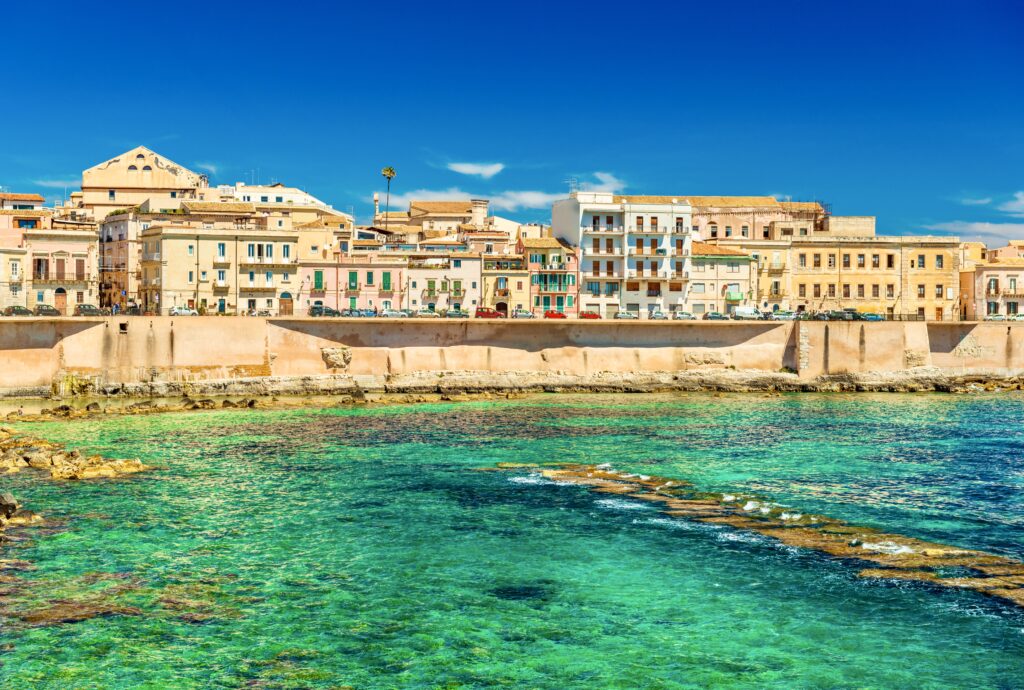
Still, Ortigia is the main attraction and is widely considered one of the most gorgeous destinations in Sicily. It’s full of ornate Baroque churches, winding streets, and hipster wine bars and trattorias.
Overview Of 2 Days In Syracuse Itinerary
Here’s a snapshot of what you’ll see with this itinerary.
Day 1:
- Old Town of Ortigia
- Temple of Apollo
- Graziella district
- Ortigia Street Market
- Via Cavour
- Piazza Duomo
- Syracuse Cathedral
- Jewish Quarter
- Bellomo Museum
- Fountain of Arethusa
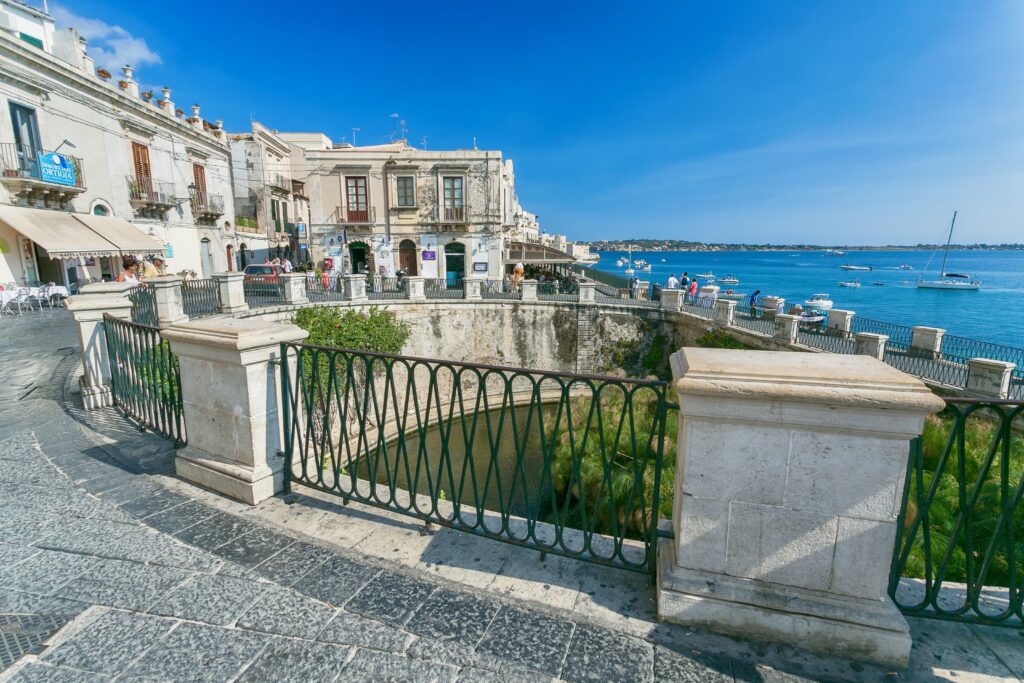
Day 2:
- Neapolis Archaeological Park
- Greek Theater
- Roman Amphitheater
- Ear of Dionysis
- Madonna of the Tears Church
- Church of Santa Lucia al Sepulcro
Tickets & Tours
Here are some of the best tours and experiences you can have with 2 days in Syracuse. Be sure to book in advance, at least from May through September.
- boat tour of Ortigia
- ticket for Neapolis Archaeological Park
- guided walking tour
- street food tour
- Syracuse day trip from Catania
- guided bike tour
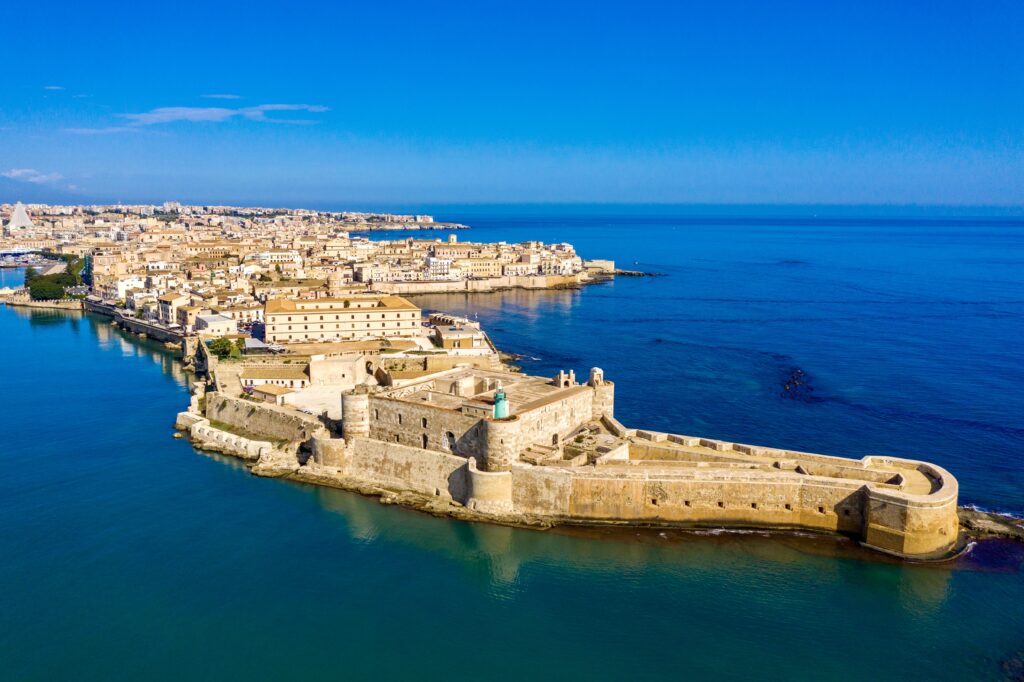
A Short History Of Syracuse
But before we dive into this 2 days in Syracuse itinerary, let’s take a brief look at the city’s illustrious history.
The Greeks founded Siracusa in 734 B.C. The city got its name from the Greek word for quail because, seen from above, the city resembles the fowl.
The nucleus of the town was the island of Ortigia, named after the goddess Artemis. She was the city’s protector.
With a strategic port on the Mediterranean, Syracuse had access to markets in southern Italy, Africa, and Rome. Soon enough, it became a powerful Greek polis (or city). The colony thrived and expanded to the mainland.
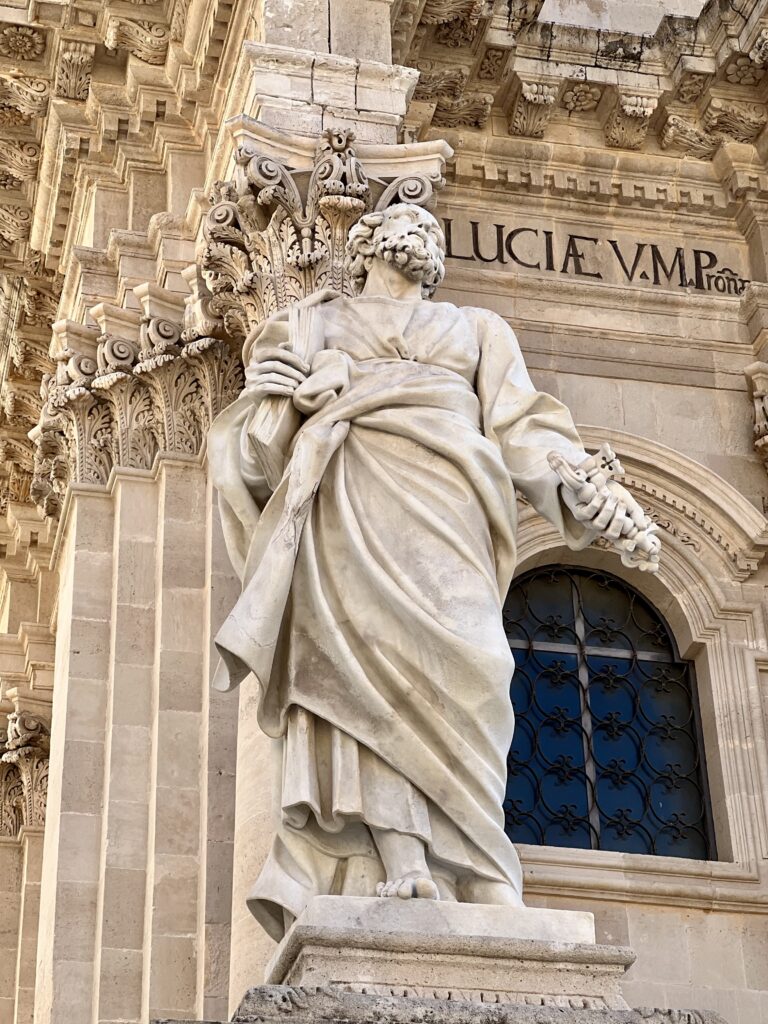
Between 214 and 212 B.C., Rome laid siege to Siracusa. For a time, the city resisted thanks to help from Carthage and the war machines built by the scientist Archimedes. But, in 212, Syracuse fell to the Romans, who would dominate the city for centuries.
In the Middle Ages, as in the capital city of Palermo, the Arabs, Byzantines, and Normans took successive control of Syracuse.
Under the Normans, Syracuse had a brief period of prosperity and many of its buildings date from this era. In the 16th century, the Spanish Aragons arrived and also left their architectural footprint on the city.
In 1693, Sicily was hit by a deadly earthquake. It severely damaged many villages in eastern Sicily, including Siracusa. They were then rebuilt in a distinctly Sicilian Baroque style.
2 Days In Syracuse Itinerary
With this 2 day Syracuse itinerary, you’ll spend one day in the old town exploring the island of Ortigia and one day in the new town, Neapolis, checking out the magnificent Greco-Roman ruins.
To get properly oriented, you may want to book a guided walking tour to help make the city and its history come to life.
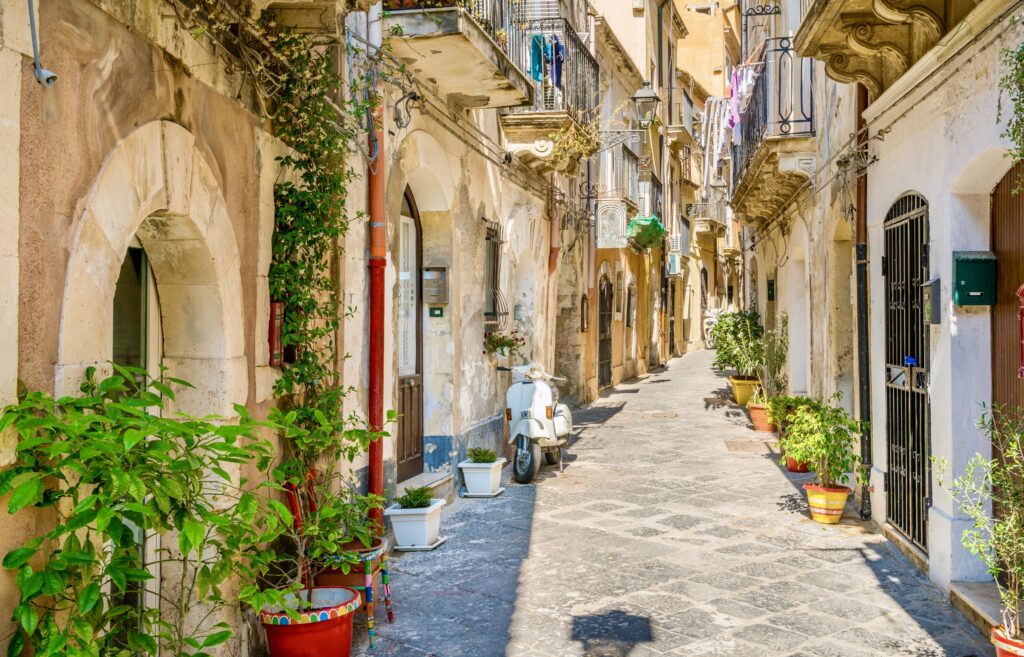
On your first day, you’ll stroll through the beautiful old town of Ortigia. Just 1.5 miles long, the island can, can should, be conquered on foot.
Ortigia is a densely woven tapestry of the many layers of Syracuse’s history. It’s fairy touristy, but for good reason. Ortigia is a visual feast and has one of Sicily’s best old towns.
At very corner, you’ll be immersed in weathered facades in pastel tones, tiny cobbled lanes, and countless flower strewn balconies. It’s been cleaned up and renovated with the help of funding from the European Union.
Start at the Santa Lucia Bridge. This is the link between the island of Ortigia and mainland Syracuse, the new town of Neapolis.
Say hello to the statue of Archimedes. Grab an espresso or pastry at Viola Express Bar, which served up some of the best coffee I had in Syracuse.
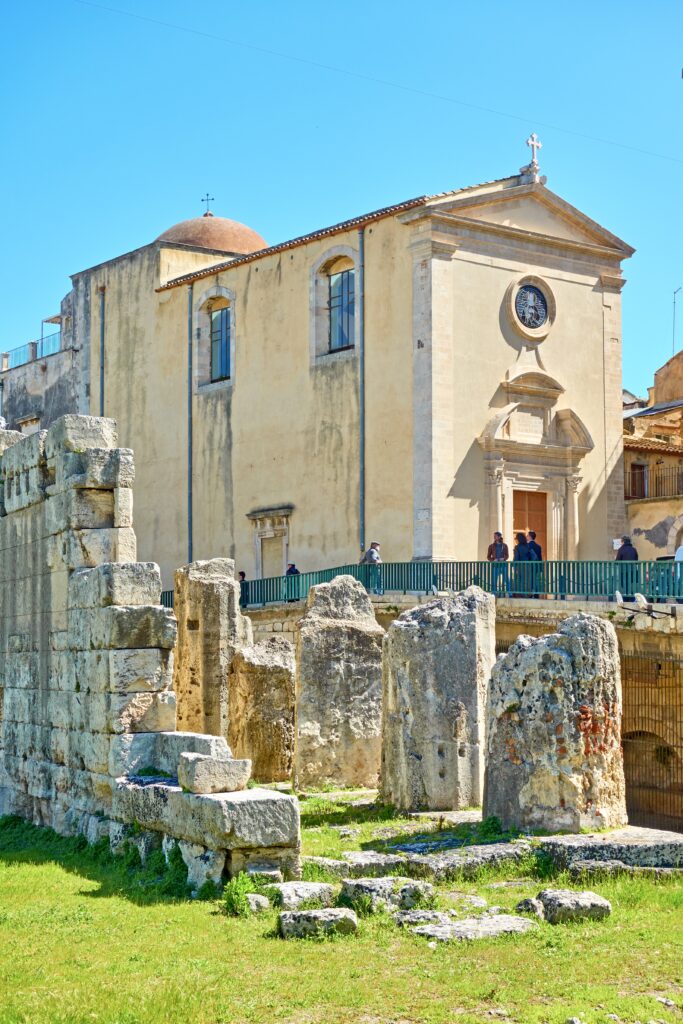
Temple of Apollo
Then, stop to admire the open air ruins of the 2,500 year old Temple of Apollo. Dating from 580 B.C., these are the ruins of the first Doric temple built in Sicily. It’s Sicily’s oldest Greek temple, built 150 years before the Agrigento’s famous temples.
You’ll see a stretch of wall from the cella (inner chamber) and some short squat columns. The columns are in the “archaic” style.
They look like tree trunks and were the Greeks first experiment in building with stone. They columns were fluted to hide the fact that the columns were built with stone drums.
Through the ages, the temple went through many incarnations — Byzantine Church, mosque, and Spanish barracks.
From the temple, you can access the three main streets of Ortigia — Via Roma, Via Matteotti, and Via Cavour. The first two are shopping streets. Via Cavour is the most picturesque, filled with unique boutiques and eateries.
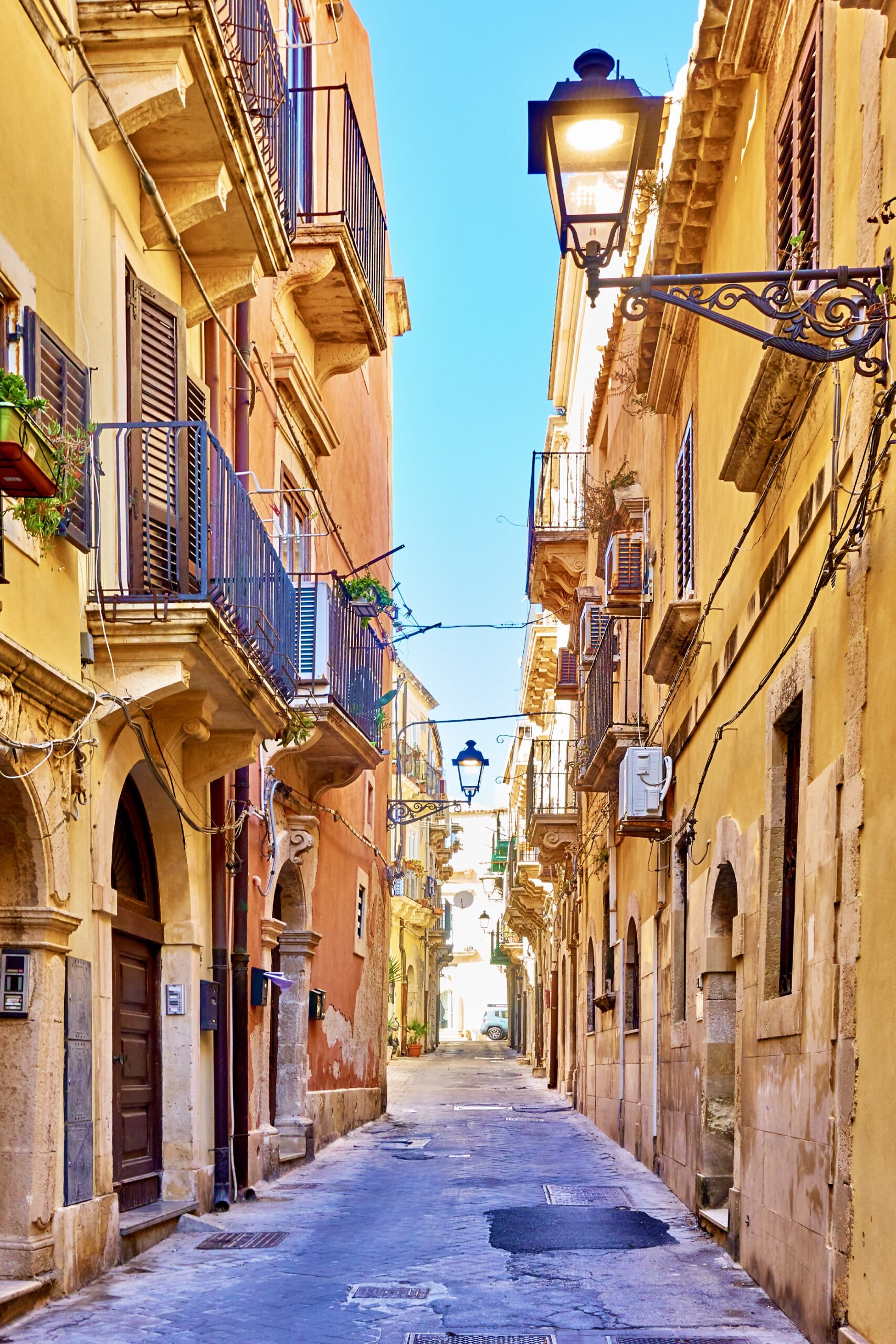
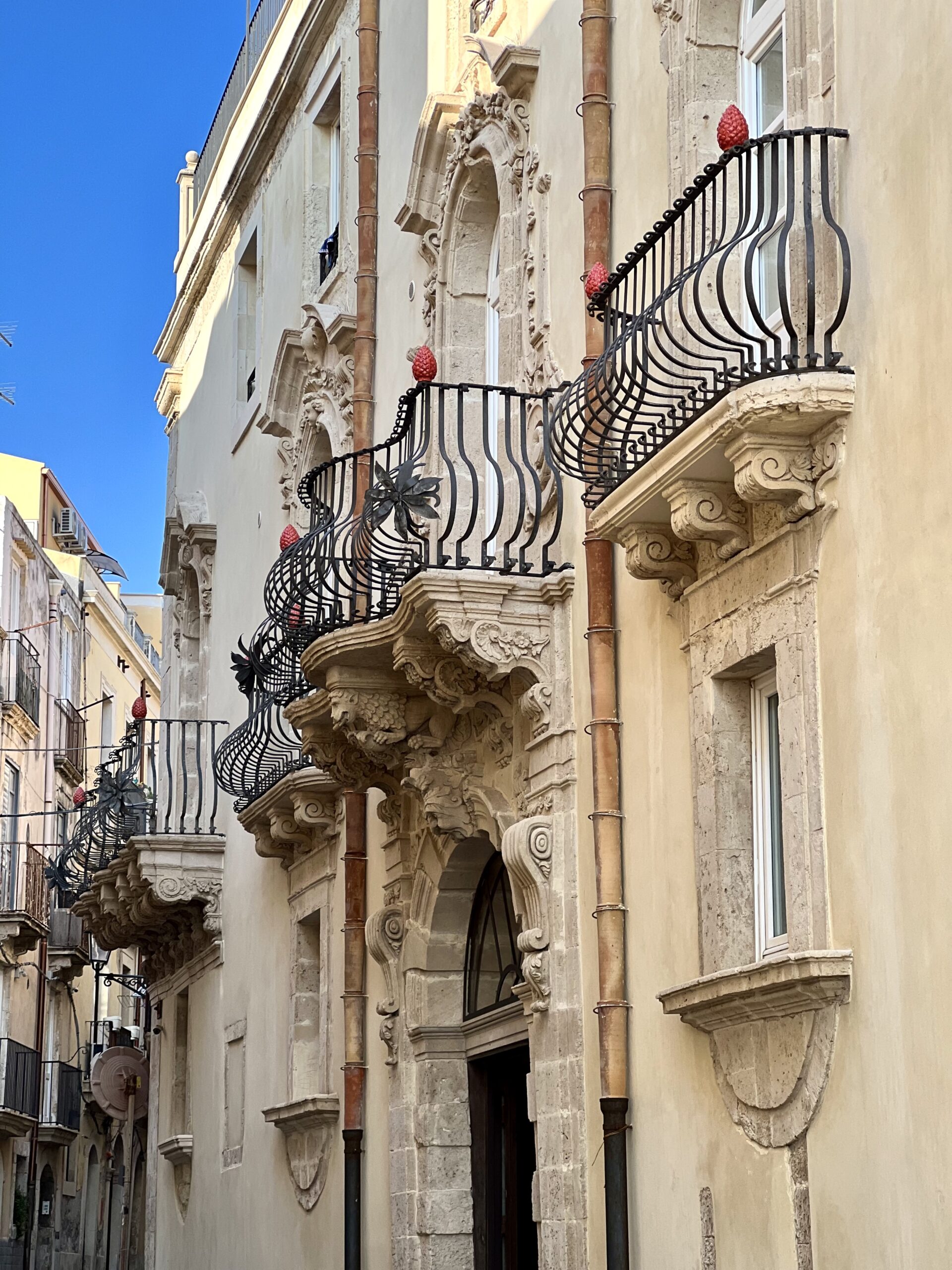
Graziella
But first take a stroll through Graziella, the old Arab quarter. It’s the most ancient and authentic part of the city. It was a rare bit not completely destroyed by the earthquake.
It’s in the northeast corner behind the Temple of Apollo. The district’s name comes from the former residents (mostly fishermen), who were devoted to Madonna delle Grazie.
In Arab times, the district was a bustling place with baths, mosques, and markets.
Largely untouched by the Normans, you’ll find a labyrinth of crumbling buildings, winding lanes, and Mahgreb style courtyards.
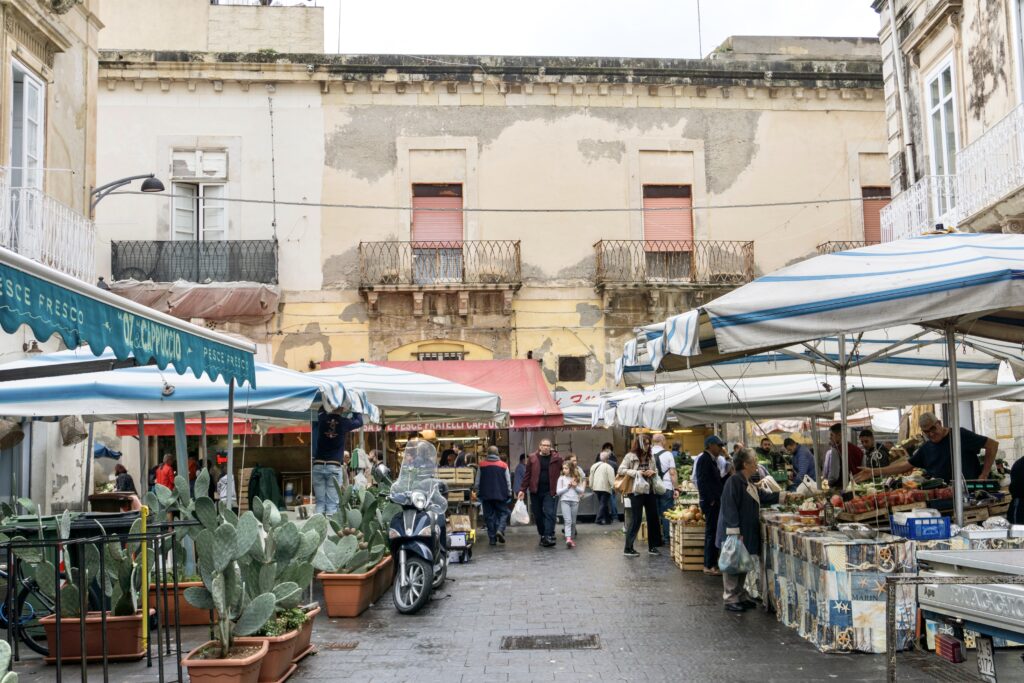
Ortigia Street Market
Next, head to the lively Ortigia Market, adjacent to Graziella. It’s open Monday to Saturday from 7:00 am to 2:00 pm.
Shops and storefronts spill out over three blocks on a single street. Vendors sell fresh fish, fruit, vegetables, and spices. Pick up a snack of pistachios or sun dried tomatoes or kiwi.
The market is also a good place to come back for lunch or to make a picnic. You can also try Caseifico Borgheri, close to the market area. It’s a colorful deli serving up the best sandwiches in Ortigia.
Alternatively, for a real local experience, you can book a street food tour or take a cooking class and learn to make arancini.
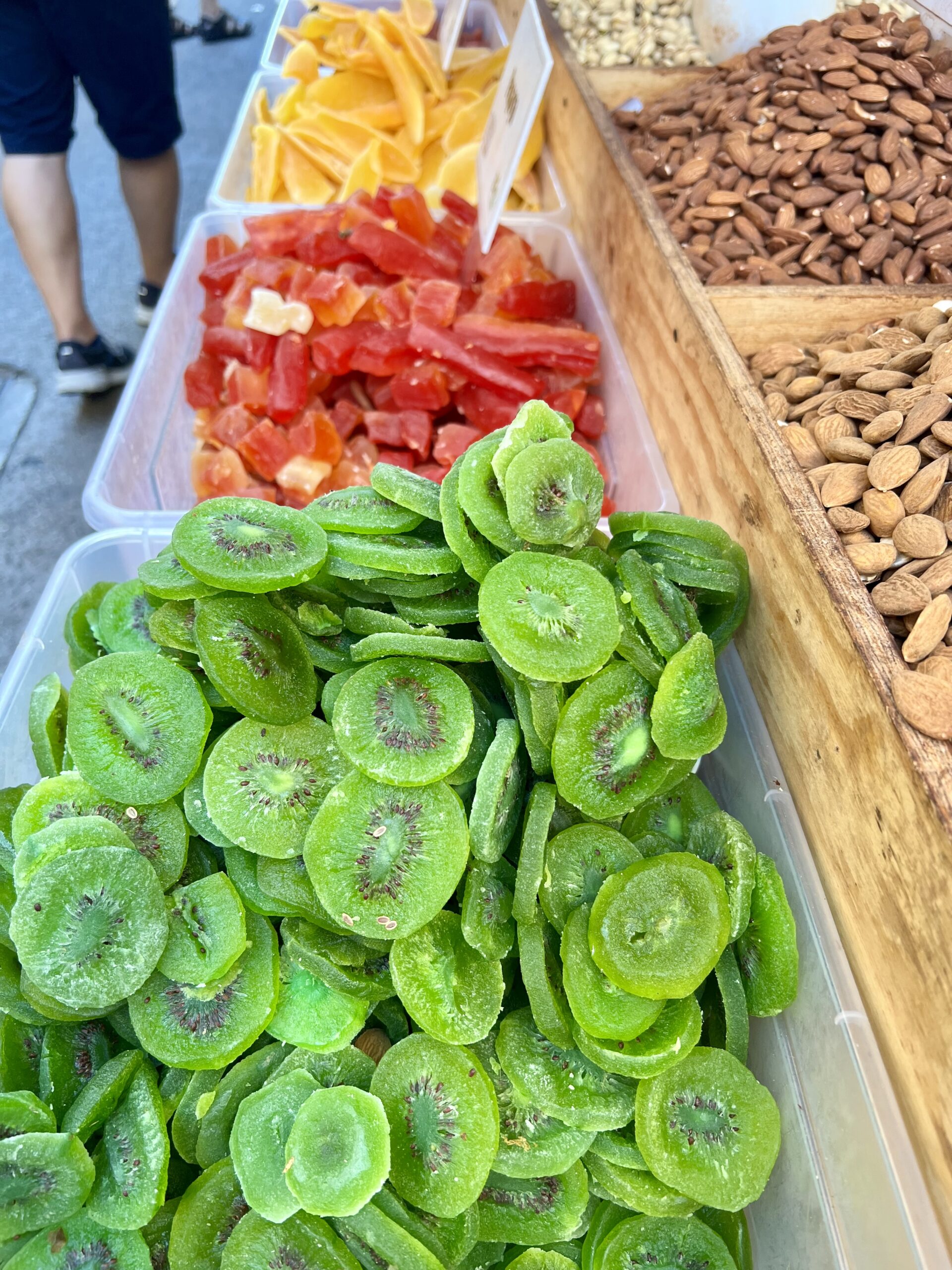
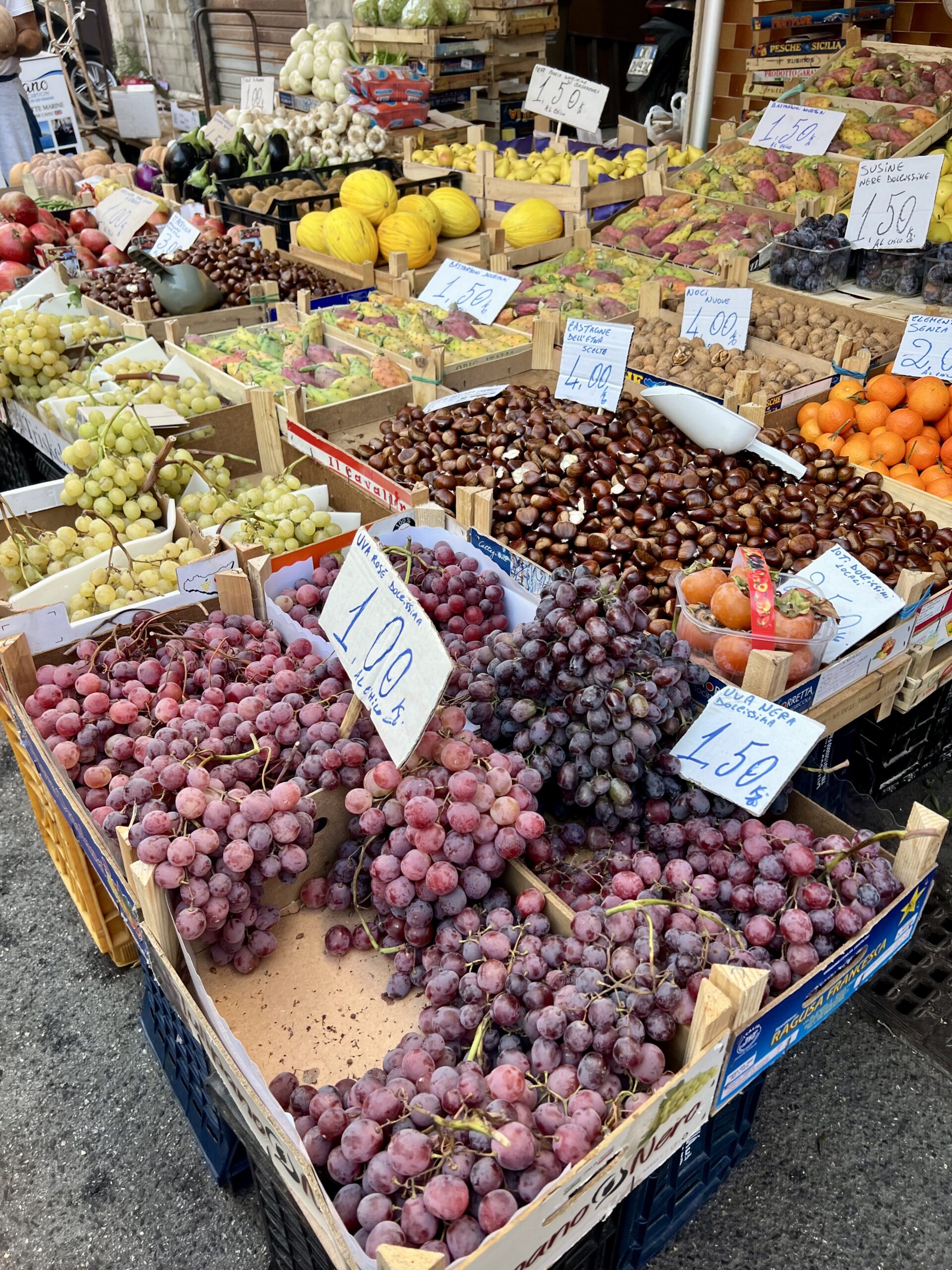
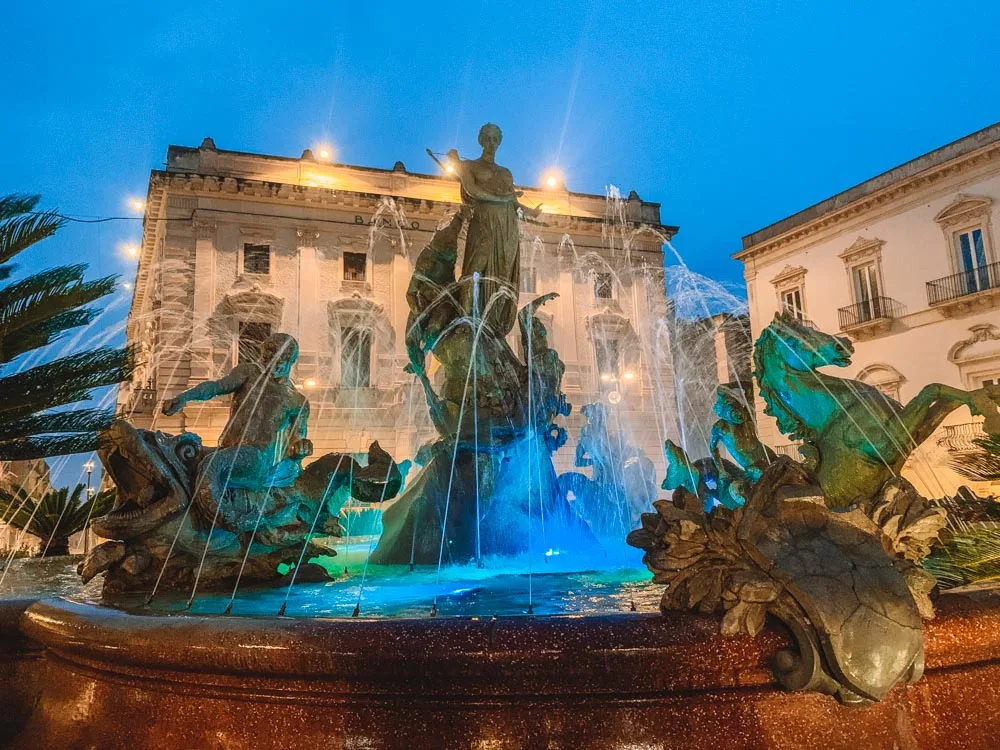
Fountain of Diana
Turn down Via Matteotti Piazza Archimedes. It’s dedicated to Archimedes, the great Greek mathematician, scientist, and philosopher.
At the center is the impressive Fountain of Diana. Diana was the Roman name for Artemis, the goddess of hunting and moonlight.
The fountain depicts the nymph Arethusa trying to avoid the amorous advances of Alpheus while being protected by Diana. Legend holds that Diana prevented the kidnapping by turning Arethusa into a spring of water.
Then, turn right onto Via Cavour and continue your stroll. Via Cavour is simply delicious, an embodiment of old Sicily.
Formerly a bit run down, today it’s one of Sicily’s most beautiful and trendy lanes, shared by both tourists and locals alike.
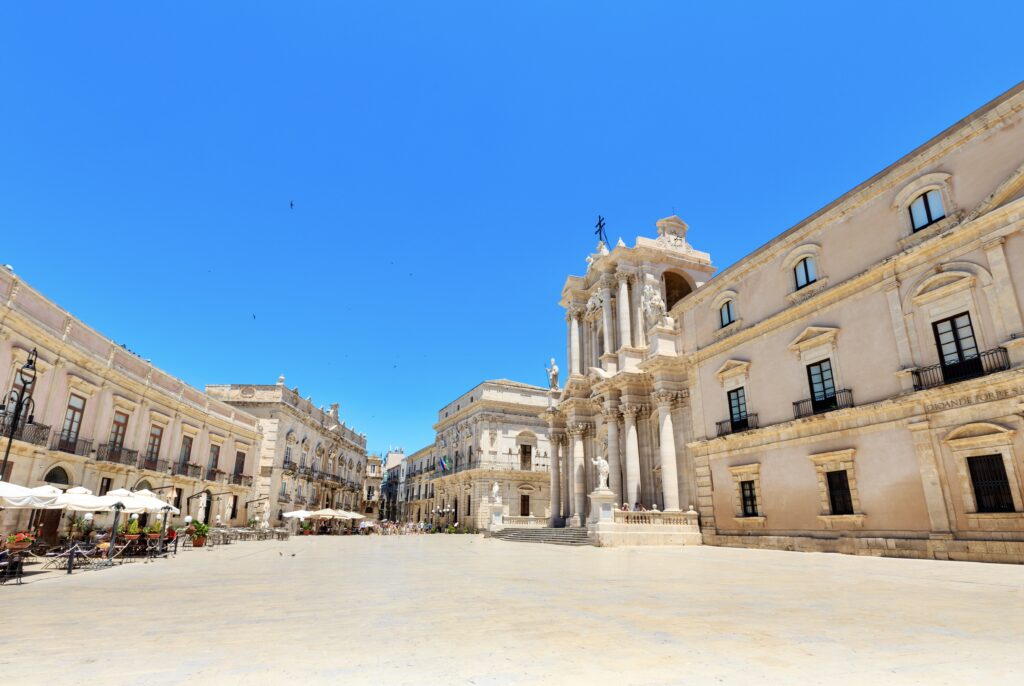
Piazza Duomo
The next thing to see is the absolutely splendid Piazza del Duomo, a Baroque space that’s the “living room” of Ortigia. It’s a graceful semicircle lined with cafes. lt’s a fine place to have an aperitivo before dinner.
The black lines in the pavement show where an early pre-Greek temple once stood.
On the right is the City Hall. At the far end of the square is the Church of Santa Lucia alla Badia. It’s a Rococo confection that once housed a Caravaggio painting (more on that later).
Santa Lucia is the patron saint of Siracusa. After witnessing a miracle, Lucia rejected an arranged marriage and pledged herself to pious chastity. That didn’t agree with her finance, who had her tortured and killed, making her a famous martyr in the process.
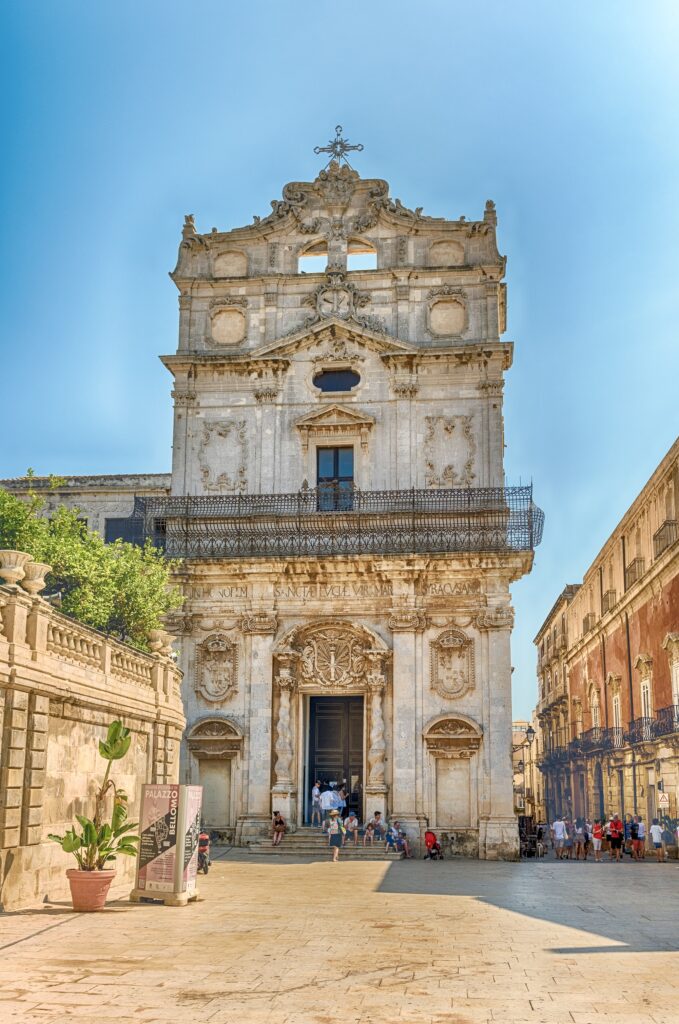
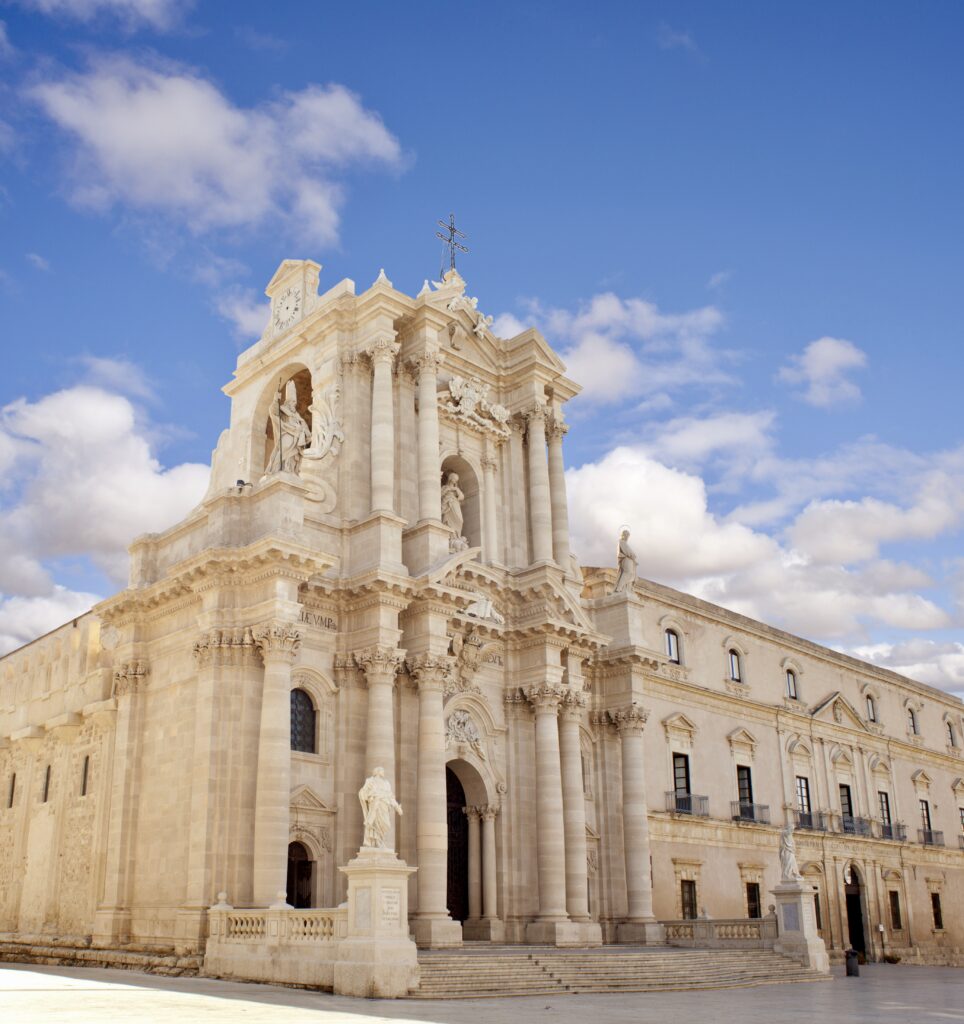
Syracuse Cathedral
Syracuse’s Duomo is remarkable, one of the most beautiful churches in Italy. It’s a fine example of the potpourri melting pot that is Sicily itself.
You can see Greek, Byzantine, Arab, Norman, and Baroque influences. But it’s a successful harmonization of dissimilar elements into a beautiful work of art.
The original Norman facade was felled in an earthquake and replaced with a finely chiseled Sicilian Baroque extravaganza. At the top is the Virgin Mary flanked by Saint Peer and Paul. To the right of Mary is Santa Lucia.
But the most astonishing and surprising part of the church is revealed on its sides. Once there was a grand Greek temple dedicated to Athena, dating from 48 B.C., where the Duomo now stands.
It had 6 columns on the front and back and 14 columns on the side. You can actually see the ancient columns on the exterior and interior of the church.
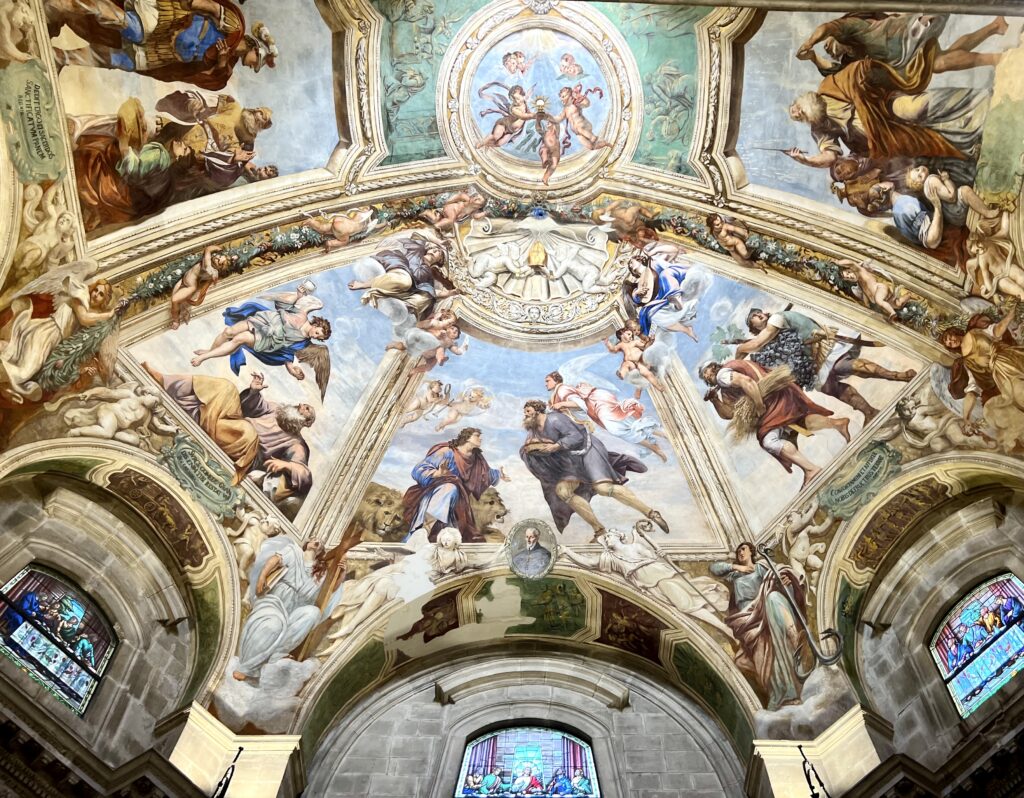
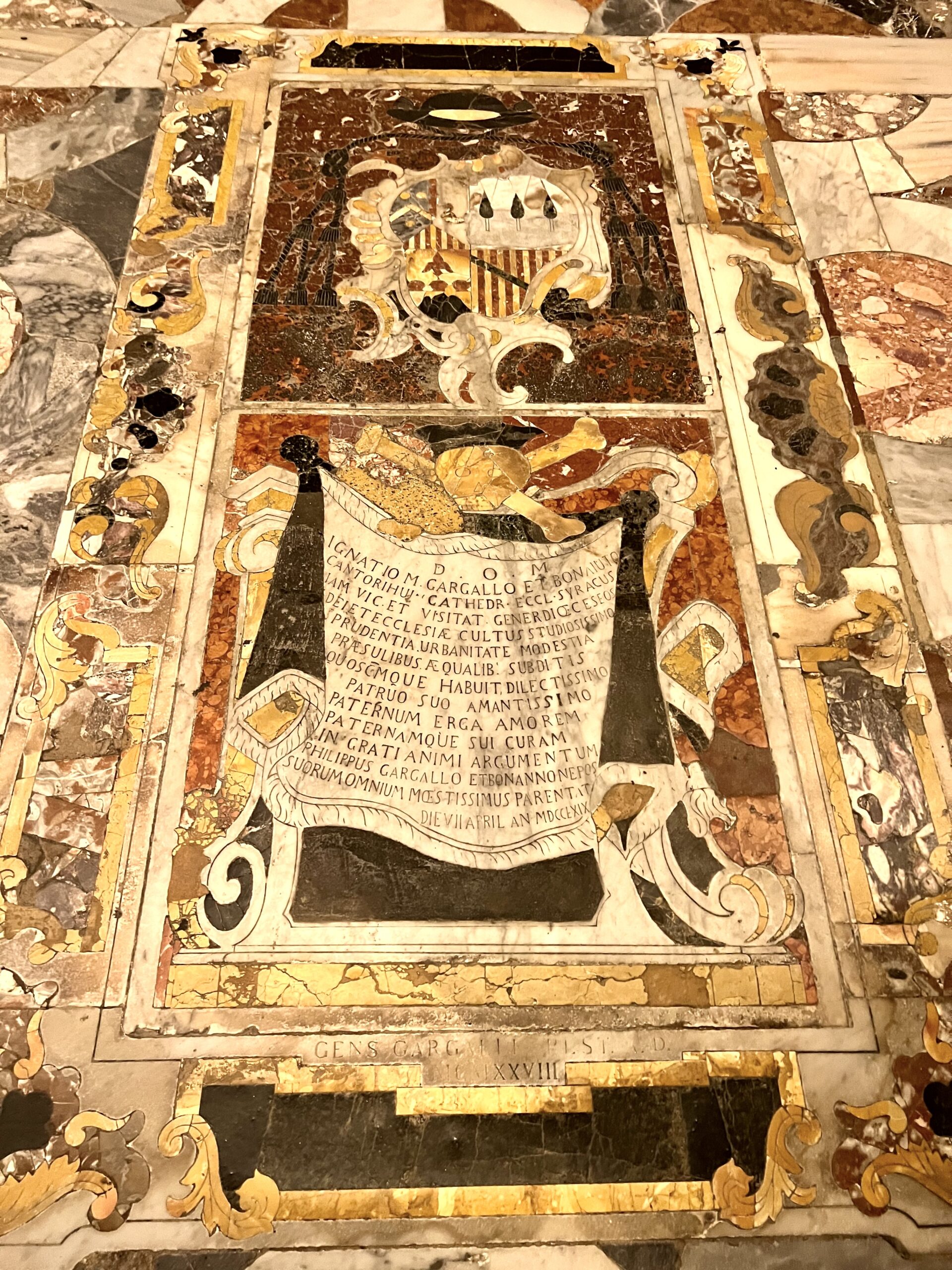
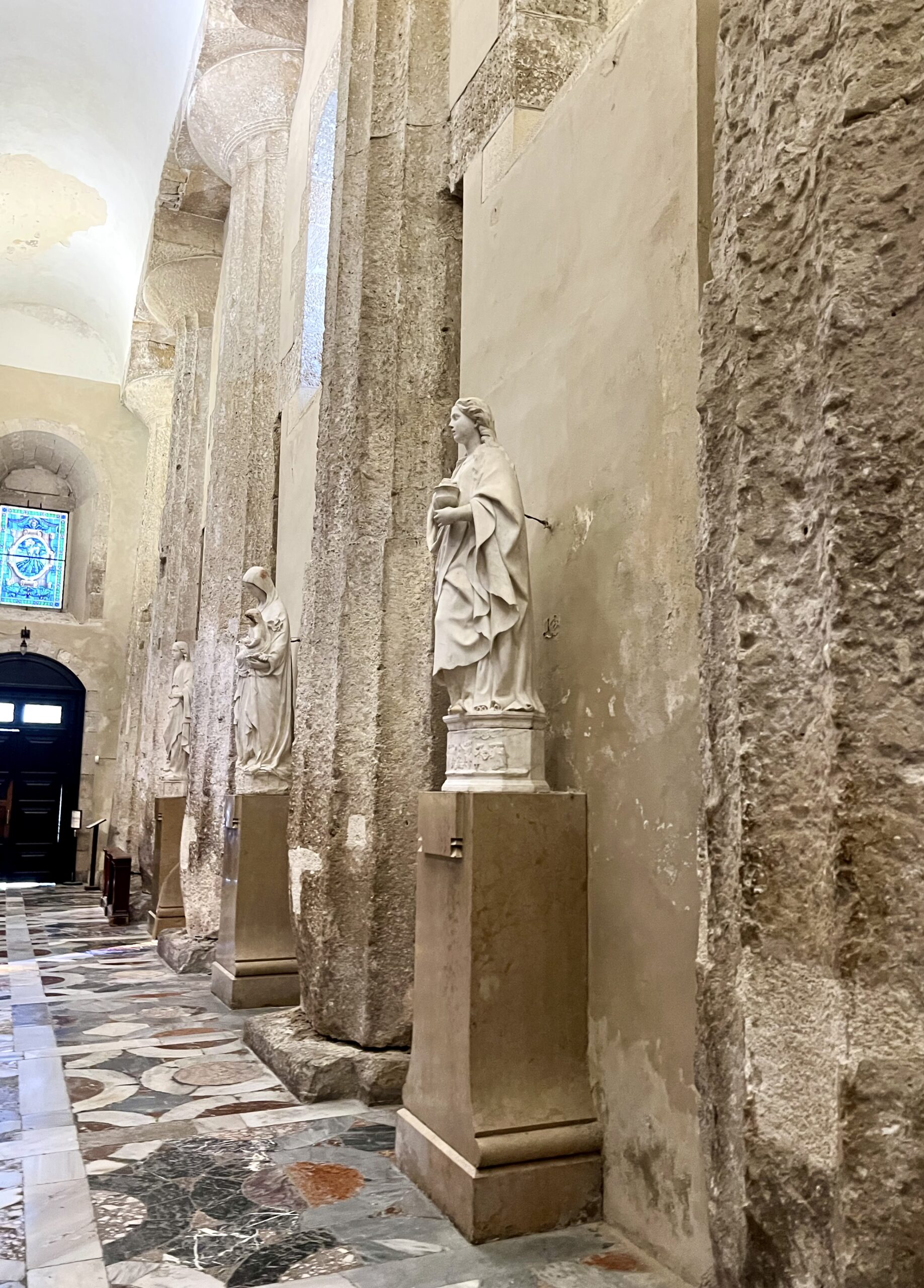
In 535, the Byzantines converted the temple into a church. To create walls, they left the columns intact and filled in the space in between them.
It’s worth a few euros to go inside to get the full effect. Pick up an audio guide. Important chapels and the like are labelled by number.
The Duomo has a severe simplicity, with a central nave and two aisles. The nave is separated by a series of arches on each side, added by the Byzantines.
You’ll see the Chapel of Saint Lucia, which contains relics including a bone from her left arm. You can also admire the gorgeous marble floors installed by the Spaniards in the 15th century.
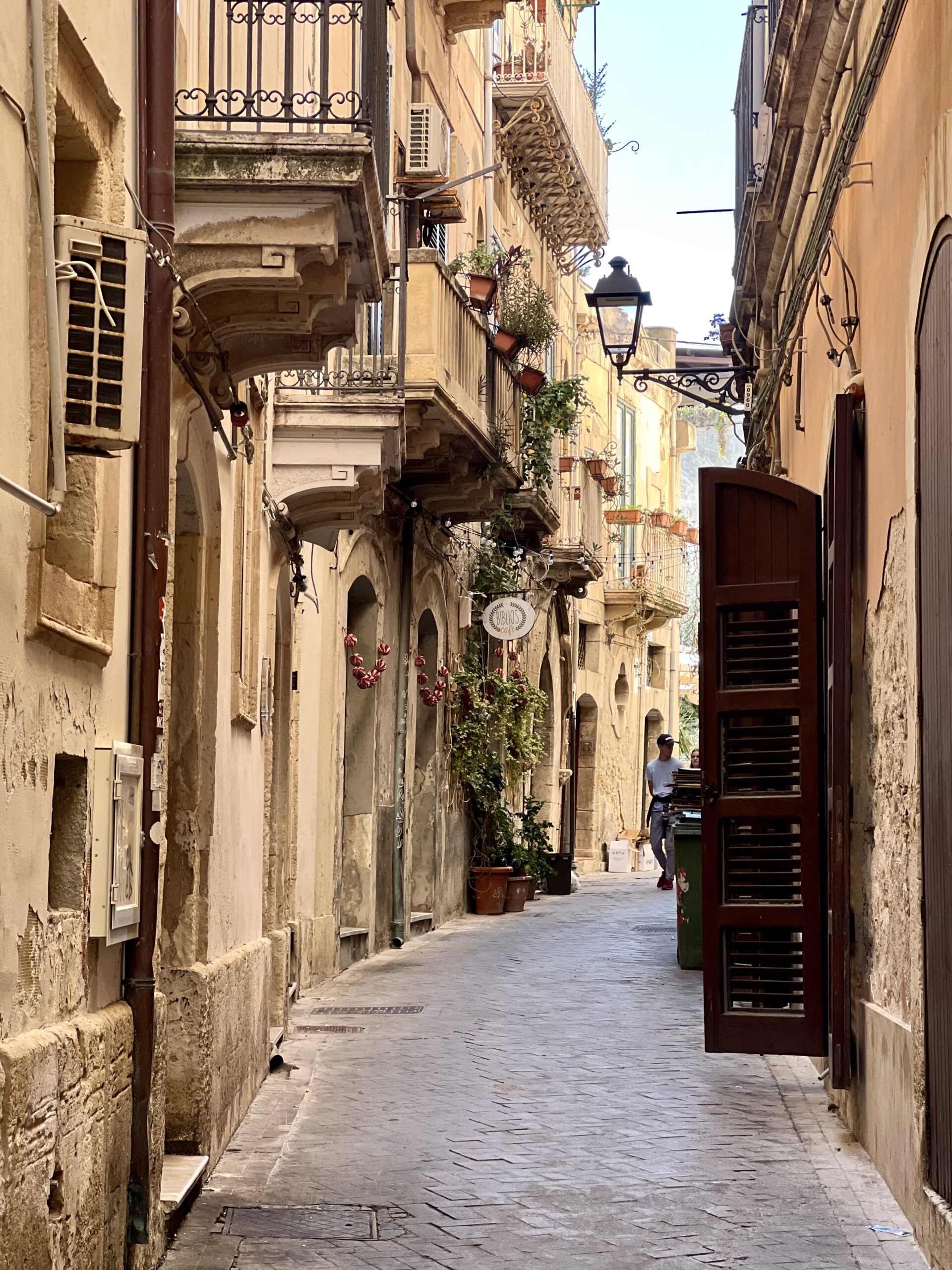
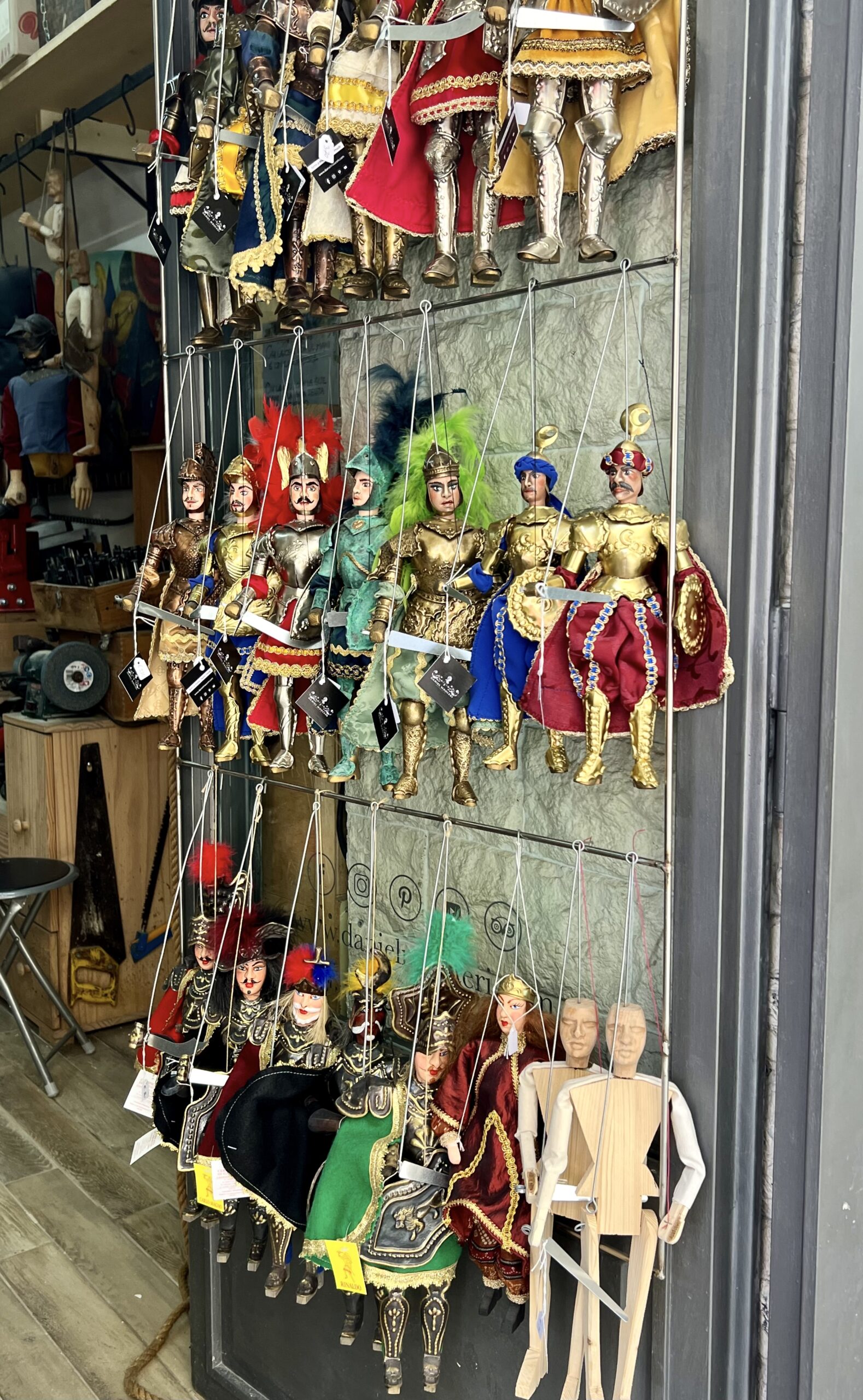
Jewish Quarter
When you’re done admiring the Duomo’s Doric columns, take a stroll through Syracuse’s Jewish neighborhood. The main drag is Via Guidecca.
The Ritual Jewish Baths are now open to the public and you can visit them on a guided tour. You’ll get a lesson on history of Jews in Sicily, see the ritual “mikvahs,” and see a network of underground tunnels.
You can also visit the Puppet Theater and the Puppet Museum.
The Puppet Theater gives performances several times a day, the last one at 5:00 pm. It’s run by the Mauceri family, who have been puppeteers for three generations.
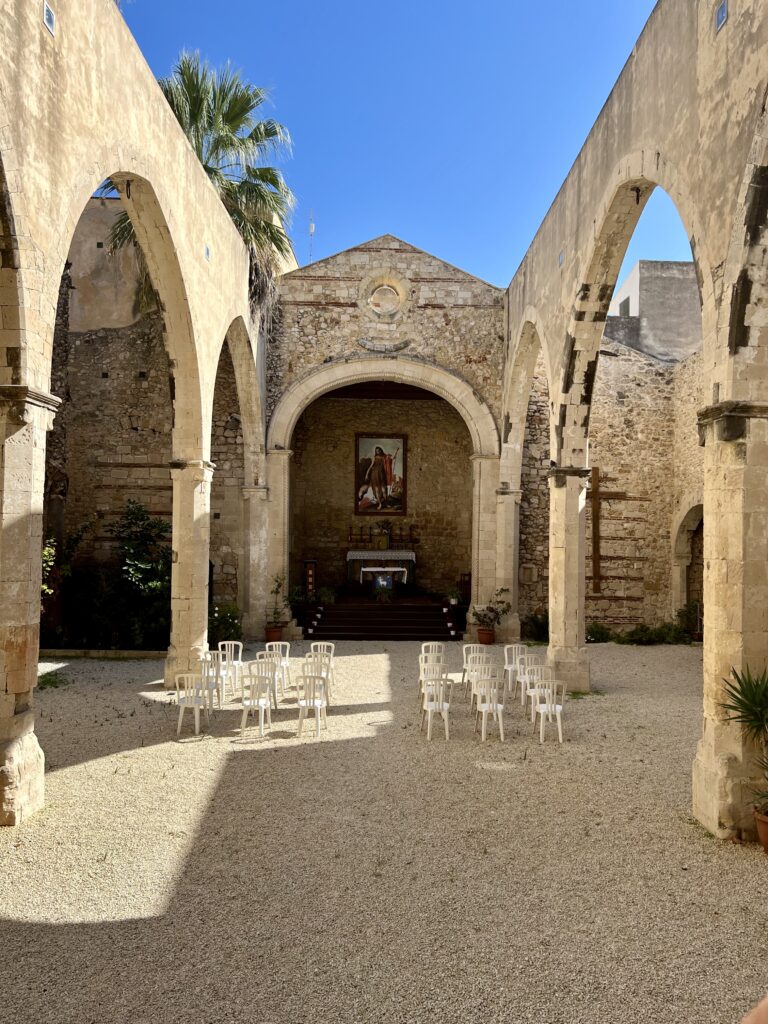
The Puppet Museum takes you on a tour of the complex history of puppetry in Sicily, from the 19th century to the present. There are puppets and figures on display.
You will also see the open air Church of St. John the Baptist. It’s a Gothic church built in the 14th century, with a nice aura of peacefulness.
If you want to grab a snack in this area, I can recommend the arancini at Antica Giudecca, a cute hole in the wall place on the main drag.
To see everything, you nay want to book a guided walking tour of the Jewish Quarter.
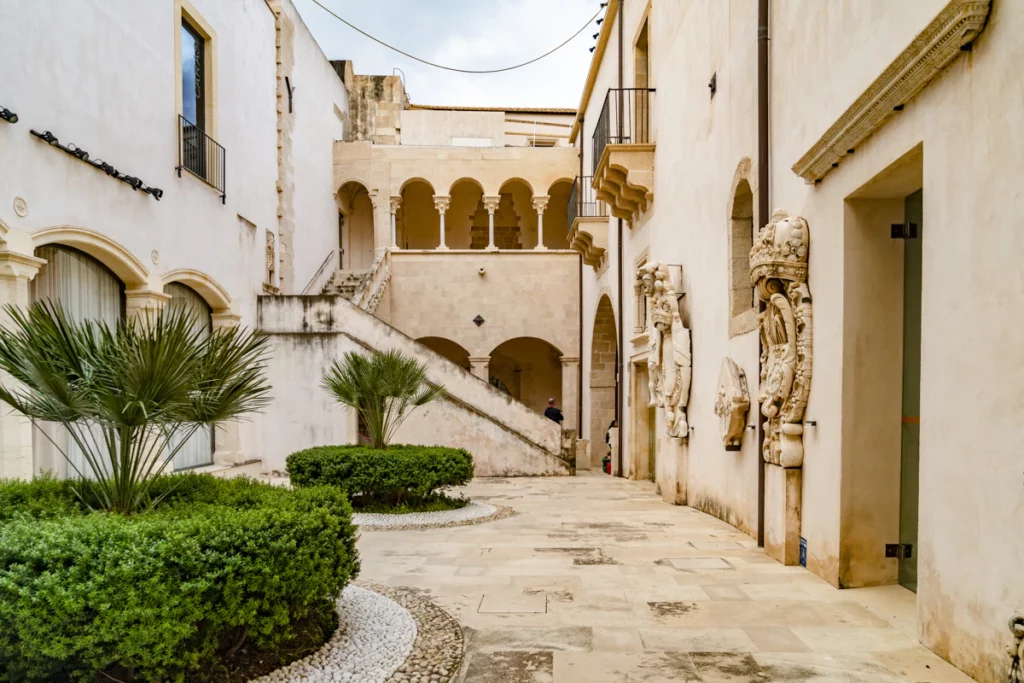
Bellomo Museum
If you’re an art lover, stop in at the Bellomo Palace Gallery.
The museum is housed in a noble palazzo and features paintings from the 15th to 18th centuries. You’ll have to pick up an audio guide because there’s almost no signage in English.
The museum’s top prize is Antonello da Messina’s Annunciation. You’ll also find altarpieces, stone carvings, a slew of madonnas, and a collection of horse carriages.
The palace restaurant, La Locandiera, is very chic with a nice selection of food and wine.
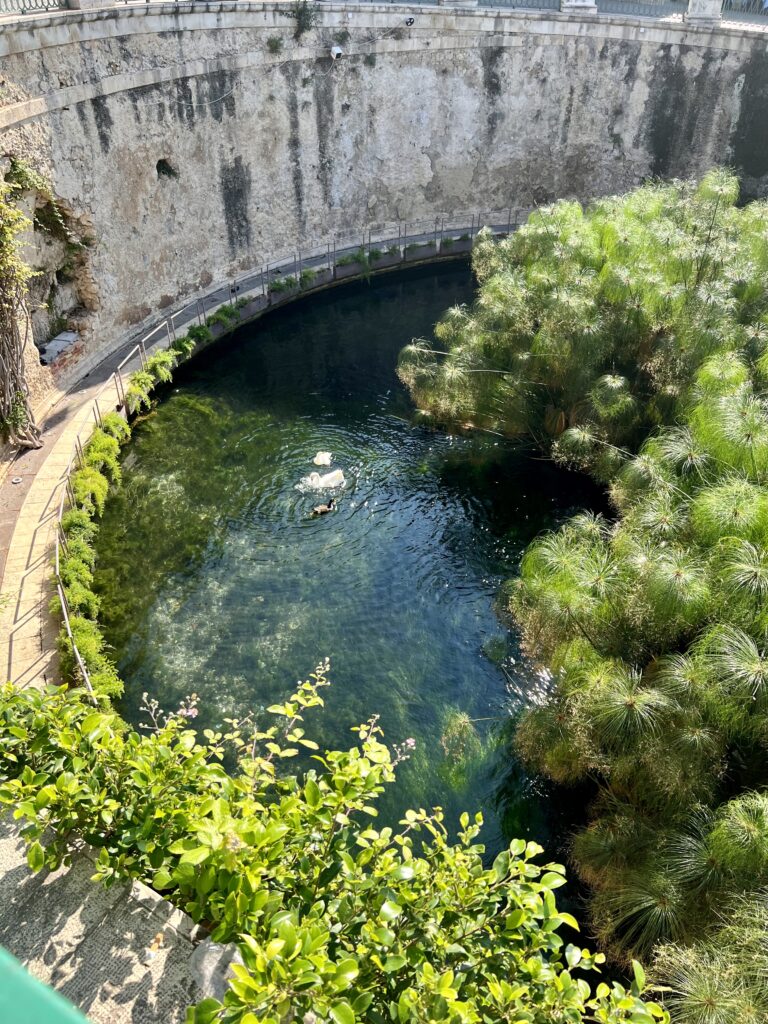
Fountain of Aresthusa
Finish up day 1 of 2 days in Syracuse at the Fountain of Arethusa, named for a nymph. The locals call it the “Fountain of Ducks.” It’s so named because you can see ducks swimming among the native papyrus plants.
Today, the fountain is just a pretty water feature. But its past is important.
This was the island’s original freshwater spring, which made Syracuse a desirable place for the Greeks to settle. The Greek believed it was connected to their homeland by an underground river. Legend also holds that a nymph was transformed into the water in the spring to escape a lecherous god.
From here, you have a viewpoint to admire Syracuse’s sweeping bay. If you want more steps, you can walk to the 13th century fortress, Castle Maniace, at the southern end of the island. A staircase takes you down to a small beach.
I didn’t have time to go inside myself. But it’s said to offer up stunning views and hosts art exhibitions.
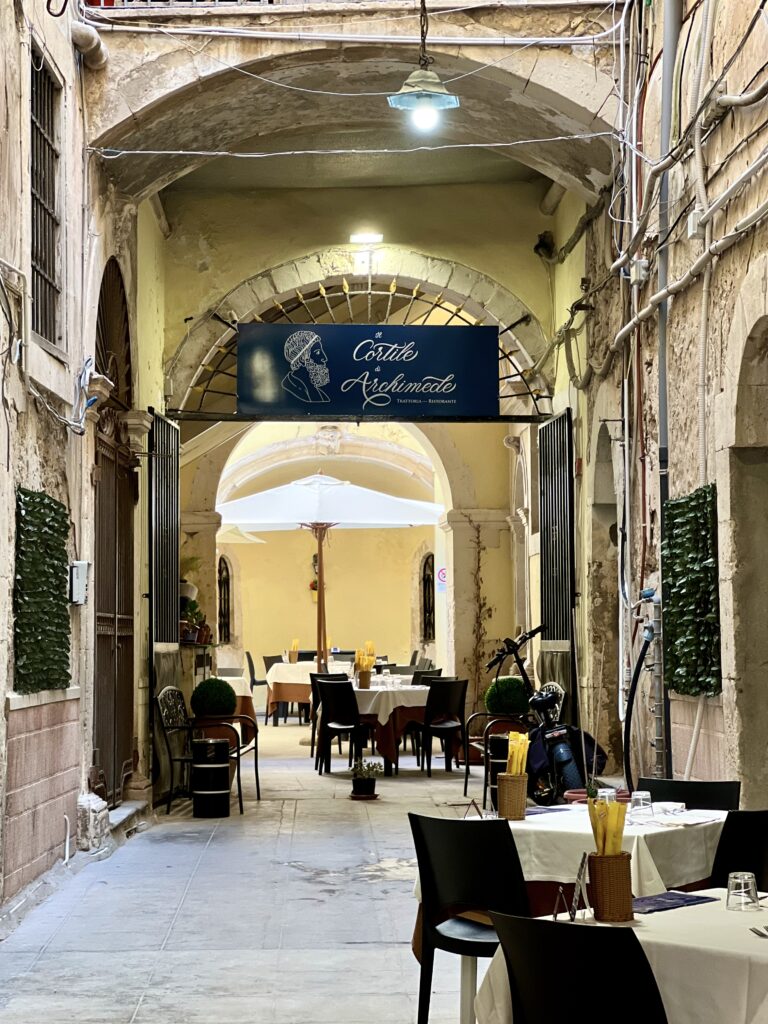
Evening
In the evening, take a passagiatta, or pre-diner stroll, on Via Cavour or the Western Promenade. The city is gorgeous at night, with many streets strung with fairy lights.
Restaurants open later than in the US. 7:30 pm is the earliest you’ll find.
I really enjoyed my meal at Siculish Ortigia. The restaurant is cozy with stone walls and wooden ceilings and the food was delicious.
I also liked Trattoria O’ Scina off on a side street with an illuminated “I Heart Ortigia” sign. And Il Cortile di Archimede is a family run restaurant in a quiet corner where you can dine in an atmospheric courtyard.
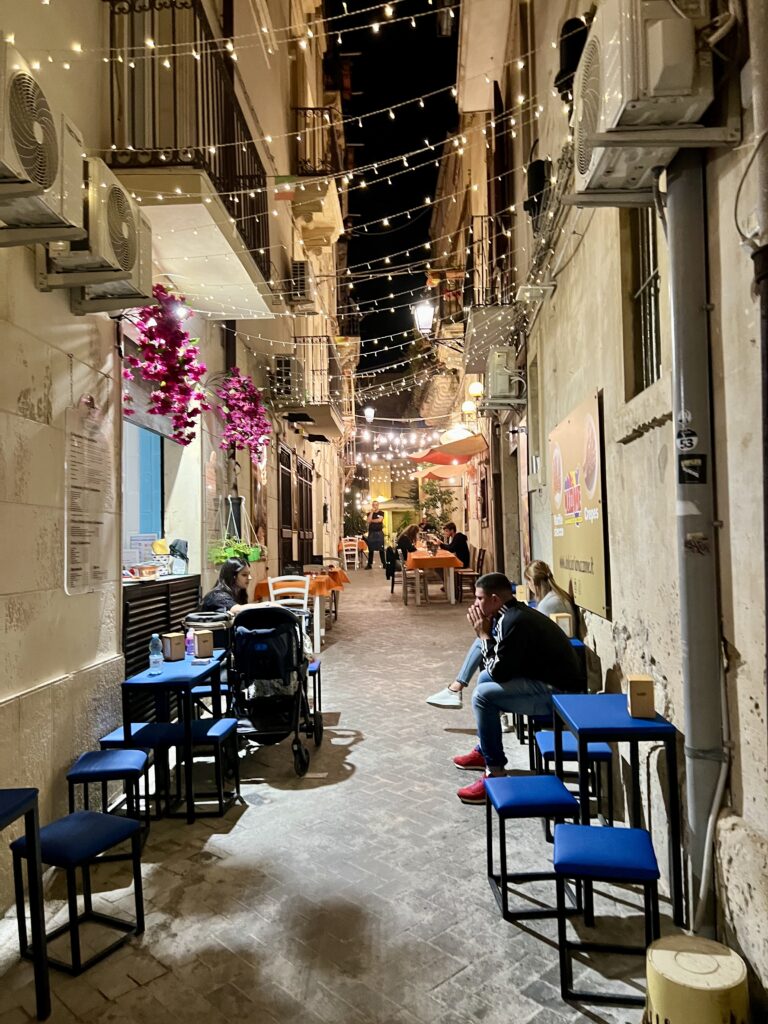
There are also loads of places on Via Cavour itself. To get a more far ranging sample of Sicilian cuisine, you could also book a guided nighttime food tour.
One day 2 of your 2 days in Syracuse itinerary, you’ll head to Neapolis, the new city of Syracuse.
It’s a bit off-putting in its modern ugliness. But, have no fear, you are there to some amazing UNESCO-listed sites at the Neapolis Archaeologial Park.
You can get there via taxi from the Temple of Apollo for 15 euros. Be careful to agree on a price before you take off in the taxi. There are also taxis waiting outside the park for your journey back to Ortigia.
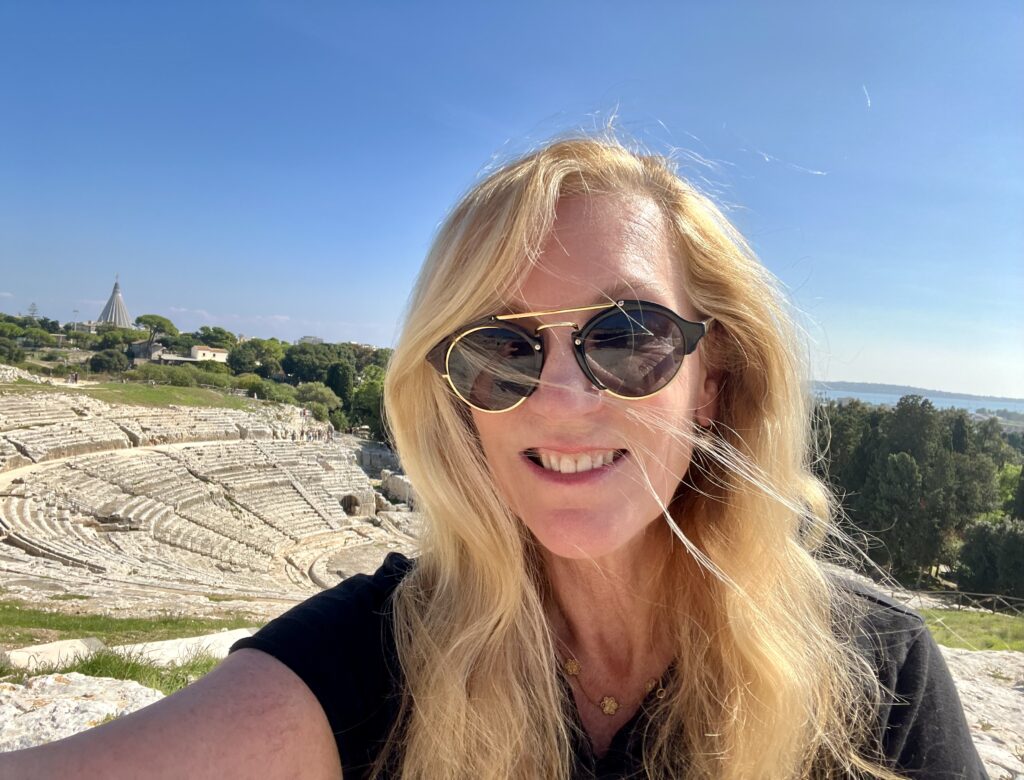
Alternatively, you can embark on a 30 to 40 minute walk. I chose the latter method just to clock some miles.
But it’s not a rewarding stroll. With the exception of some Greek ruins, you’ll see nothing but urban sprawl.
However, on the way there, you can have breakfast or an espresso at Voglia Matta, a very nice gelato and pastry shop on Via Corso Umberto just across the bridge.
You can also take minibus 2 (€1, 15 minutes) from Molo Sant’Antonio, on the west side of the main bridge. Purchase tickets on board the bus.
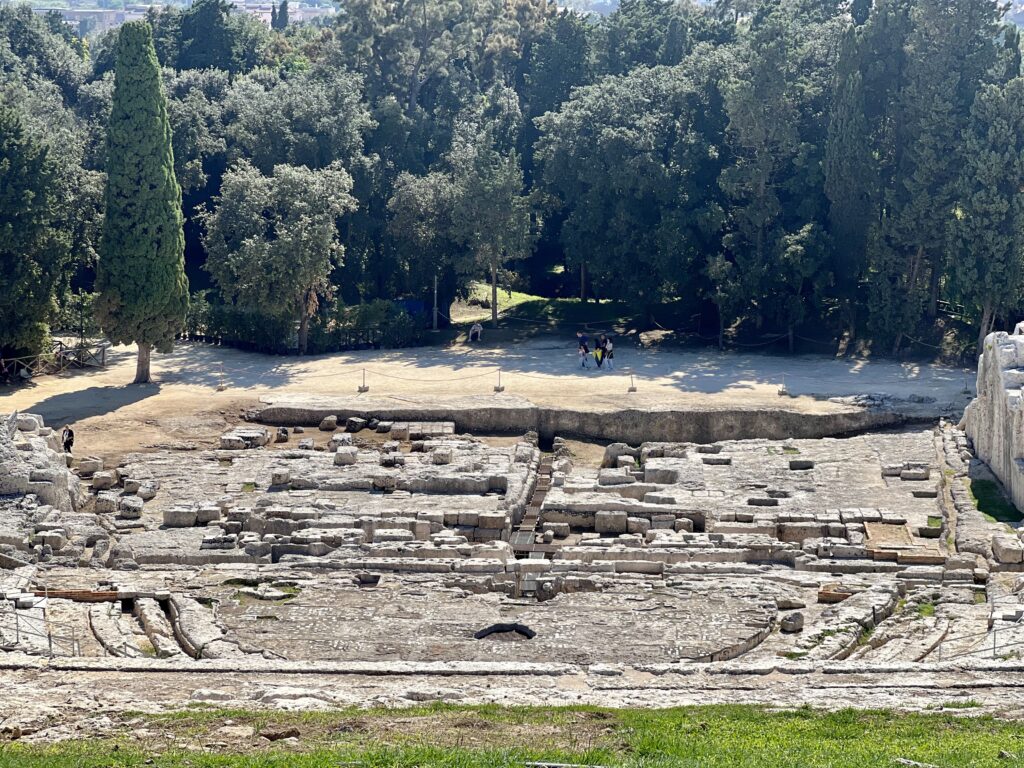
Neaopolis Archaeological Park
The UNESCO-listed Neapolis Archaeological Park is a must visit with 2 days in Syracuse, especially for a Classicist or history buff.
It features one of the largest and most impressive Greek theaters in existence, as well as an elliptical Roman arena. There’s not much signage, so I recommend booking a guided tour.
There is a ticket kiosk to the left at the entrance to the park. There are various tickets you can purchase. If you are short on time, you can just buy a ticket to the Greek Theater. You an also book a skip the line ticket in advance.
I bought the “complete ticket” for 15 euros. You’ll need to keep your ticket with you and handy because you’ll need to scan it several places.
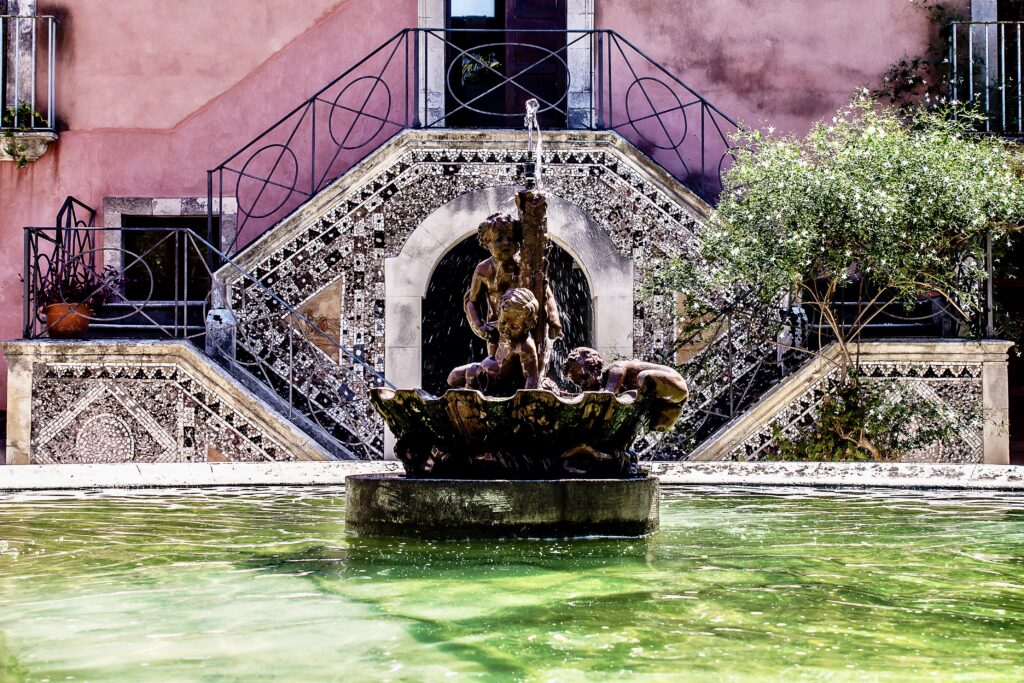
Paolo Orsi Archaeological Museum
It’s best to start your visit at the extremely well-curated Archaeological Museum. It’s one of Sicily’s best archaeological museums, housed in a blocky modern building over 2 floors.
The collection includes artifacts from prehistoric to Roman times from Eastern Sicily. You’ll see coins, sarcophagi, Greek vases, and statuary. You’ll see all the Greco-Roman deities in ceramics or sculpture.
Important masterpieces are the headless Kourus di Megara and the Sarcophagus of Adelphia.
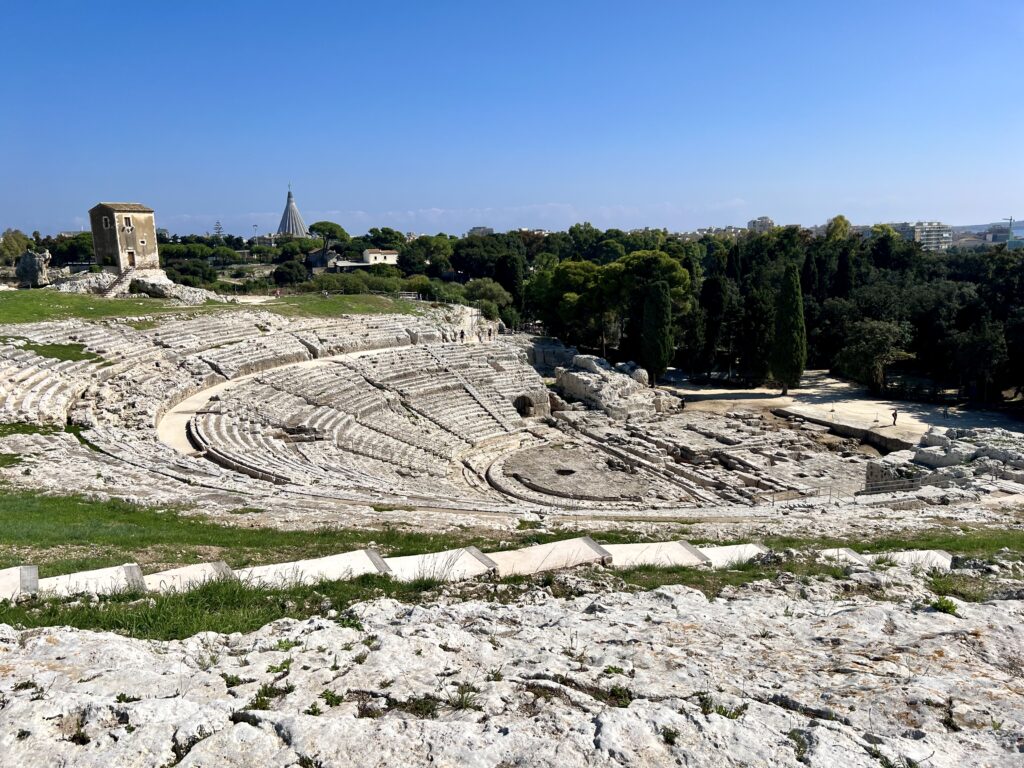
Greek Theater
Next up is the Greek Theater, Syracuse’s most important monument. To get there, scan your ticket at the turnstile and proceed straight ahead. It’s not well marked. The signs suggest you turn right, but you should head straight.
The theater is a grand sight, remarkably well-preserved, and you can view it from above and below. It dates from 500 B.C. It had a seating capacity of 15,000 with the seats carved directly into the stone.
Not much is left of the stage, only incisions in the rocks. But you can see an underground passageway that was used to link the stage and the orchestra.
In the Greek age, only men were allowed to act and they played female parts with masks. The Romans made some modifications when they came along and began using the theater for water games. It’s not know whether there were gladiatorial games.
Today, the theater still hosts performances in the summer, with wooden seats installed to protect the stone.
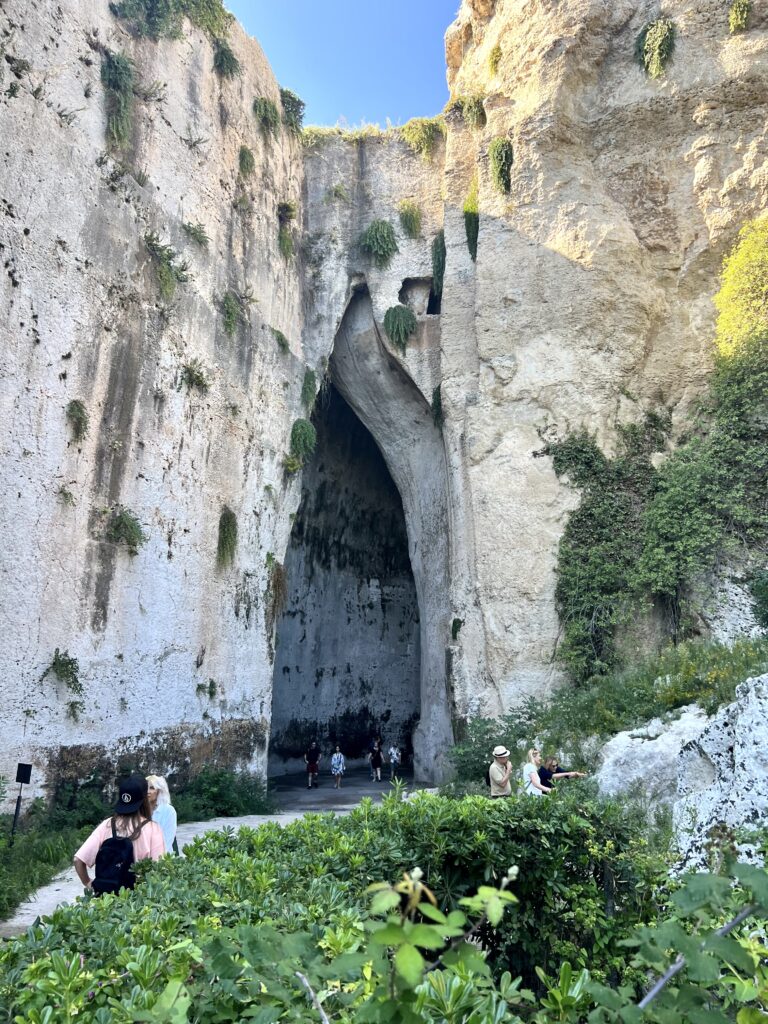
Paradise Quarry
After the theater and following the signs, you’ll come to the mysterious Latomia del Paradiso with a series of grottos, or latomie. It’s a limestone quarry from which slaves extracted stone for the ancient city.
Now bathed in lemon and orange trees, the caves were once used as prisons by the tyrannical rulers.
Perhaps the most well-known and visually arresting of the various grottos is the Ear of Dionysius, named for the tyrannical Roman ruler who ruled Syracuse from 432 to 367 B.C. It’s an otherworldly soaring cavern that’s 75 feet high.
Legend holds that Caravaggio gave it this name when he observed that the cave’s entrance resembled an enormous ear. It’s famous for its acoustics, which echo around the cavern. It was designed that way to allow rulers to listen to their penned up prisoners.
There are other grottos as well and can you can wander into a few of them.
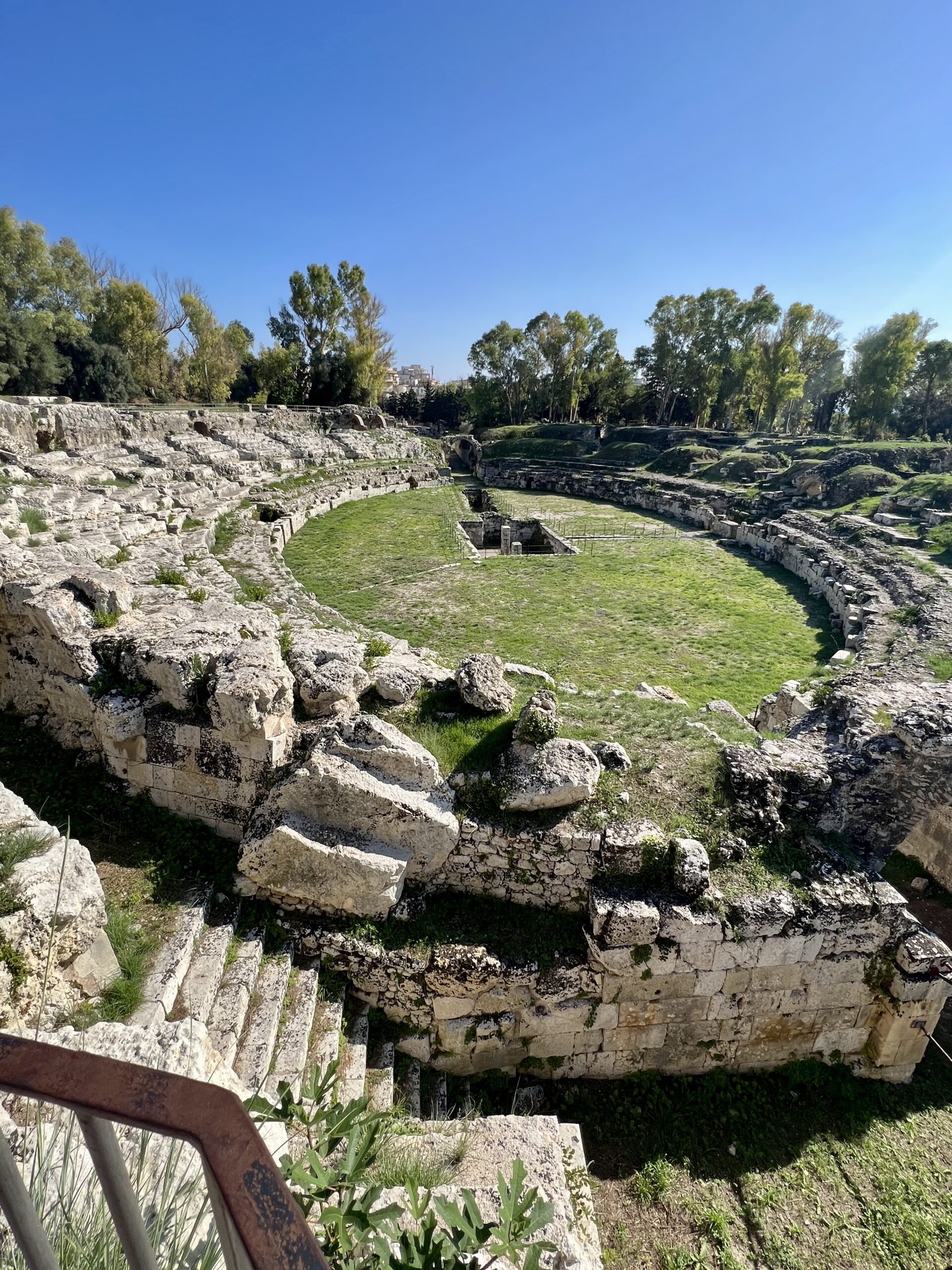
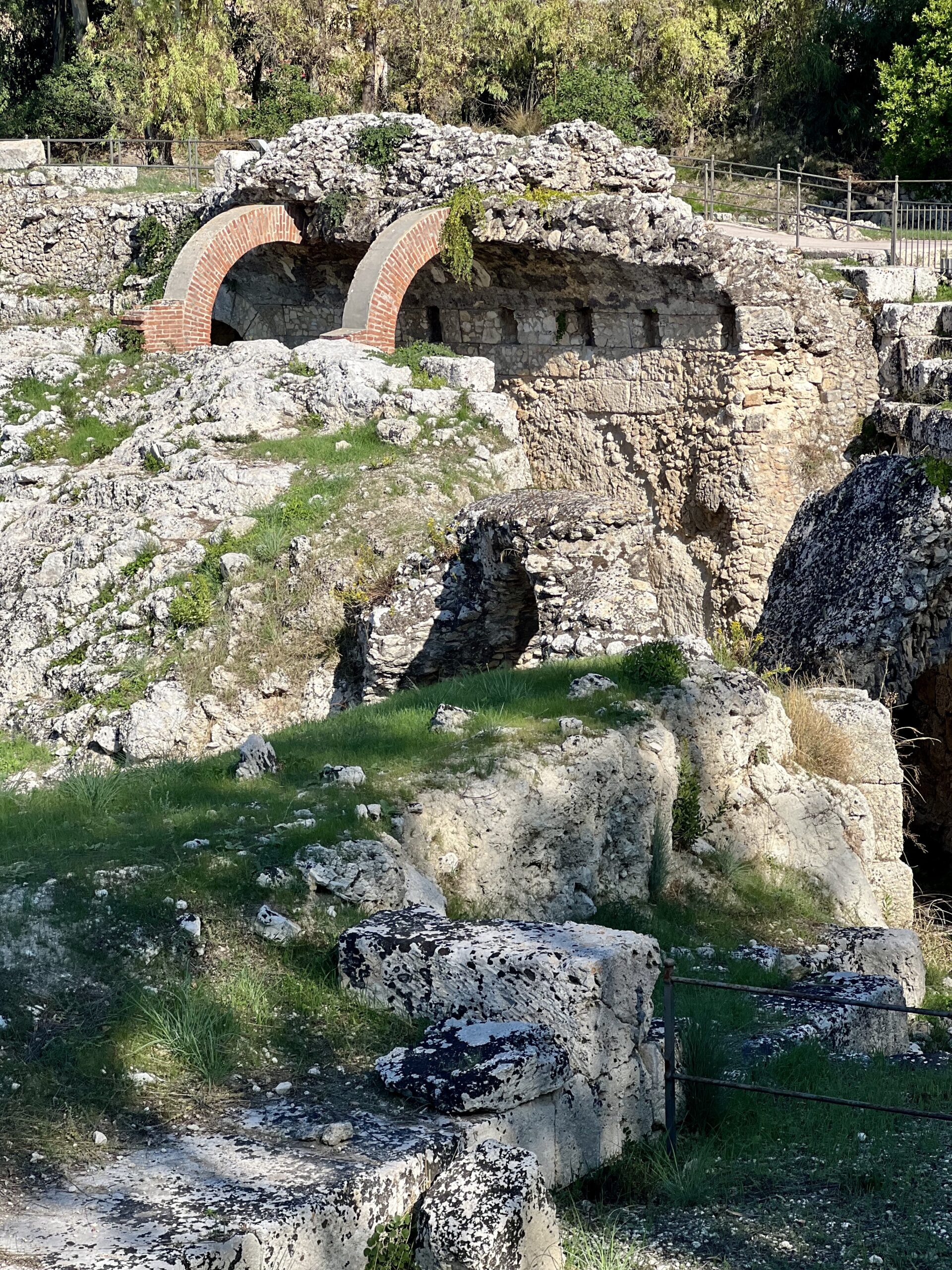
Roman Amphitheater
Your last stop will be at the Roman Amphitheater, which dates from 212 B.C. For the best view, head top to the upper level.
While the Greeks built theaters into existing landscapes, Roman theaters were freestanding. The Romans used the arena for gladiatorial combats and horse races. You can see the archways under which the losers of the battles were carted away.
In the 16th century, the Spaniards, indifferent to archaeology, destroyed much of the arena, using it as a quarry to build Ortigia’s city walls.
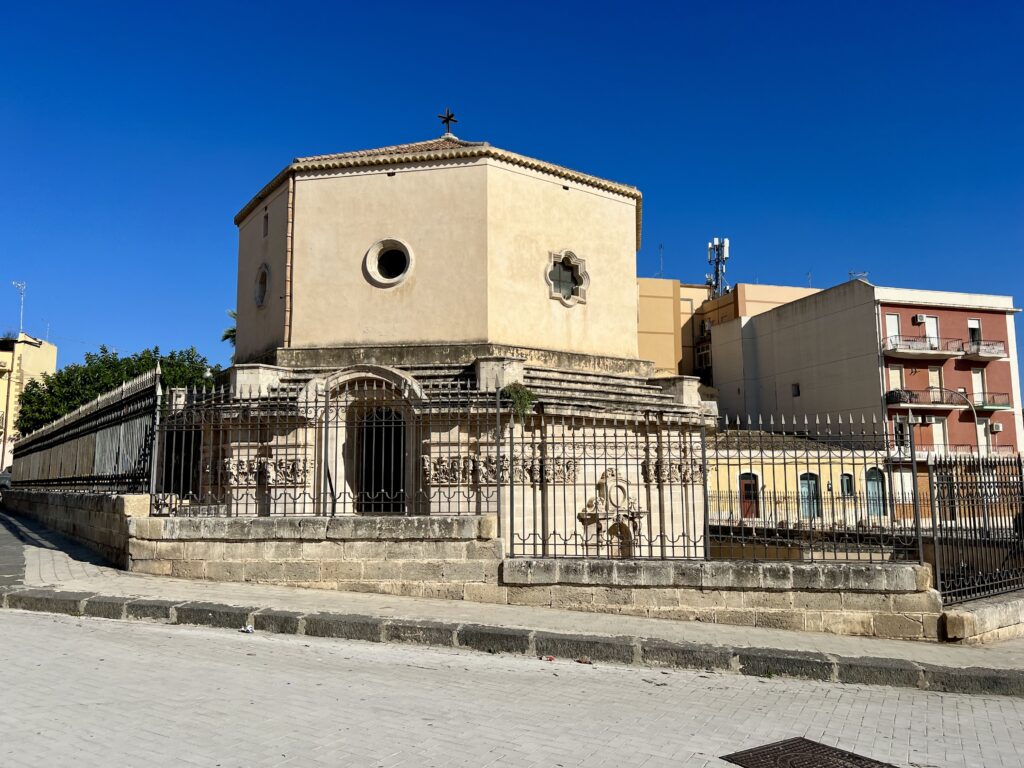
Caravaggio Painting
Art lovers should proceed next to the Church of Santa Lucia al Sepulcro to see the Baroque artist Caravaggio’s magnificent The Burial of St. Lucia.
The Internet will tell you that it’s in the Church of Santa Lucia on Piazza Duomo or the Bellomo Museum in the Jewish Quarter. But, in fact, it’s on the mainland in Neapolis.
The Sepulcro is about a 20-25 minute walk from the archaeological park. On the way, you will pass the Sanctuary of the Madonna of the Tears.
It’s a modern church that’s a pilgrimage church. You can’t miss it. You can see the church tower from anywhere in Syracuse.
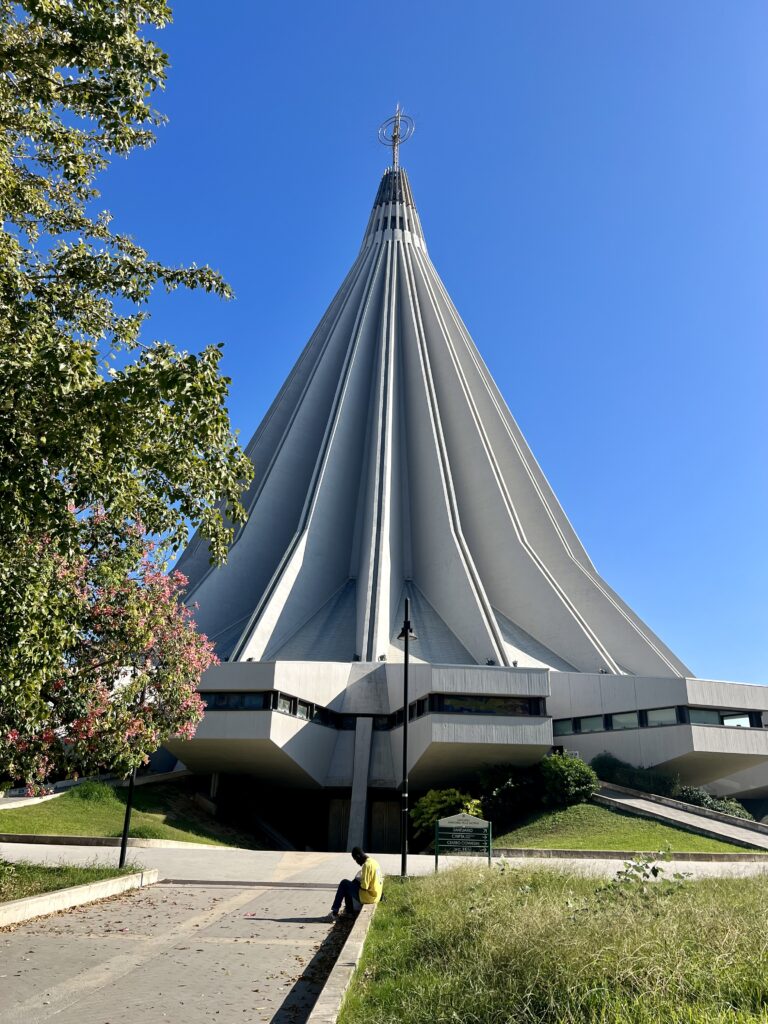
The church was built to commemorate the miraculous tearing of a statue of the Virgin Mary in 1953. The church was the result of a design competition, which made the church a trailblazer in religious architecture.
After a quick visit, continue on to the Sepulcro Church. Make sure you check the opening hours; it’s closed for a chunk of the afternoon.
I arrived around 4:00 pm when it said it was opening at 3:30 pm. But it wasn’t in fact open until 4:30 pm.
If you arrive early, head next door to visit the Catacombs of Saint Lucia. To visit, you will need to take a guided tour lasting 30-40 minutes.
The tunnels seem to go on for miles and are a bit haunting. You aren’t allowed to take photos.
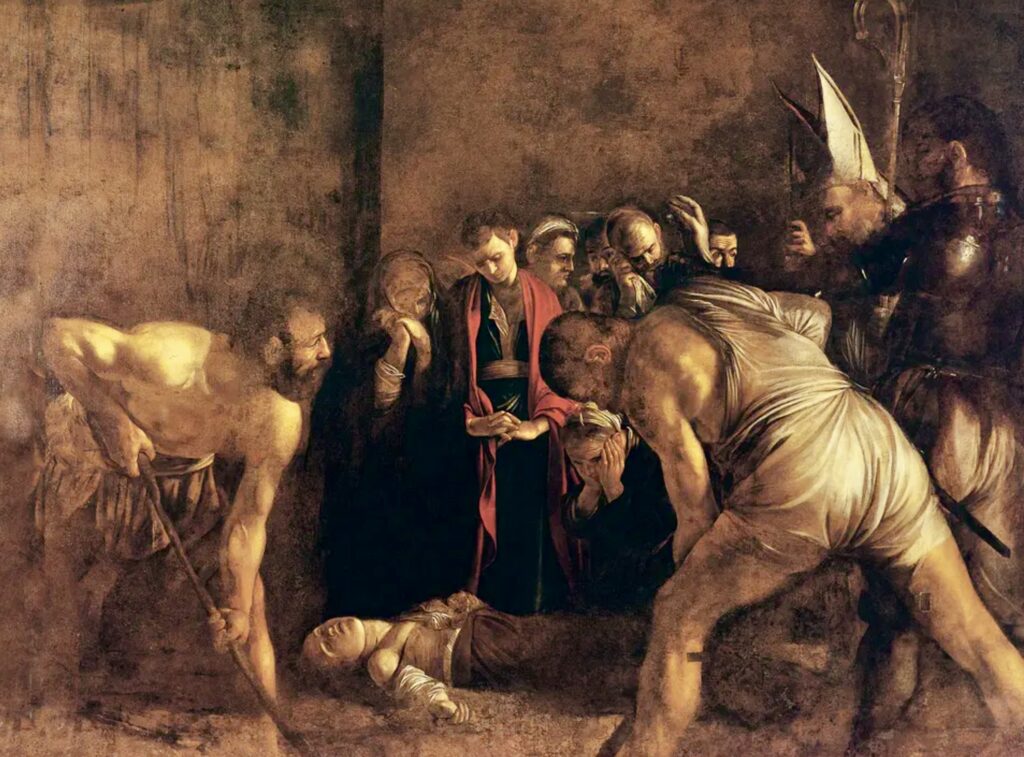
Then, it time to one of Syracuse’s wonders — Caravaggio’s The Burial of St. Lucia. It’s once of the artist’s most beautiful paintings, completed when Caravaggio escaped to Sicily to avoid a murder charge in Rome.
The painting depicts the internment of the city’s patron saint with her delicate frame stretched out at the bottom of the canvas. She’s surrounded by mourners and an enormous gravedigger.
The action transpires in a vast expanse of empty dark space of sepulchral gloom, with Caravaggio’s signature chiaroscuro technique. For centuries, the painting lie damp and damaged. But it was recently restored in Rome.
Evening
To polish off your 2 days in Syracuse, take another passagiata. Have an apertivo at the lovely Cortile Verga and grab some savory Sicilian food.
A couple great spots in Ortigia are La Foglia and Osteria da Mariano.
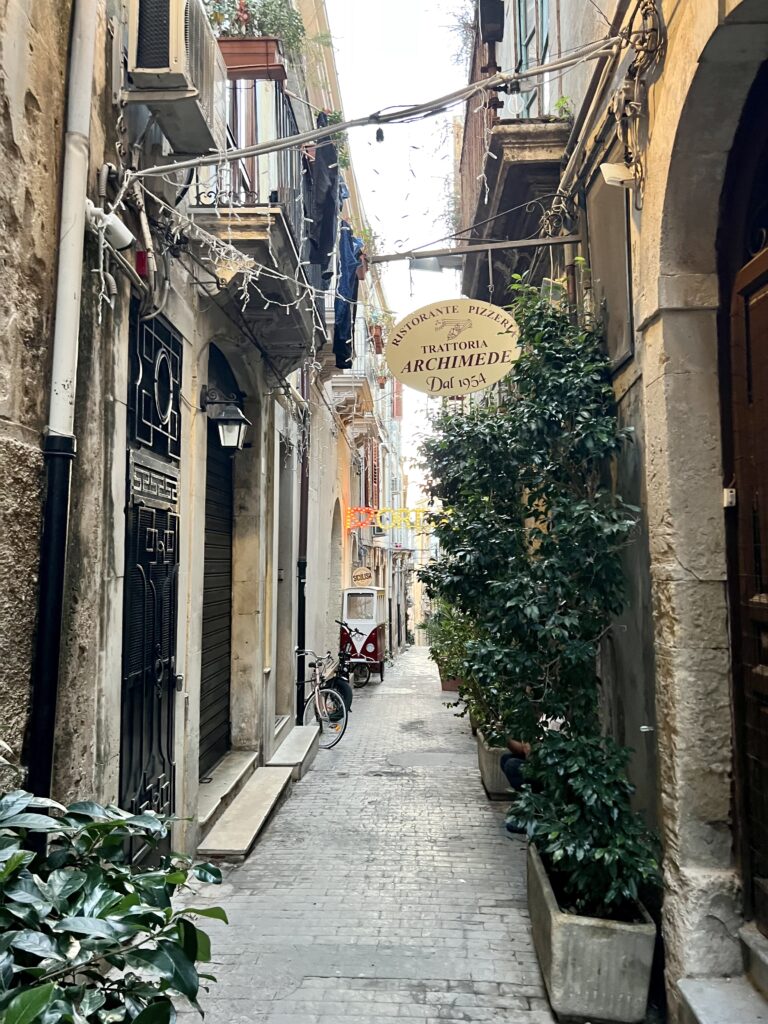
Tips For Spending 2 Days In Syracuse
1. How To Get To Syracuse
To get to Syracuse, you can either drive (if you have a car) or fly into Catania. From Catania Airport, you can take a taxi or book a private transfer.
Syracuse also has a train station. It’s located in the southern part of the new city close to Ortigia. There are several daily trains that run from Catania to Syracuse.
2. How To Get Around Syracuse
As I mentioned above, the island of Ortigia is eminently walkable and is closed to all but resident vehicles.
If you are driving, you will have to park your car at one of the parking lots on the northern edge of Ortigia.
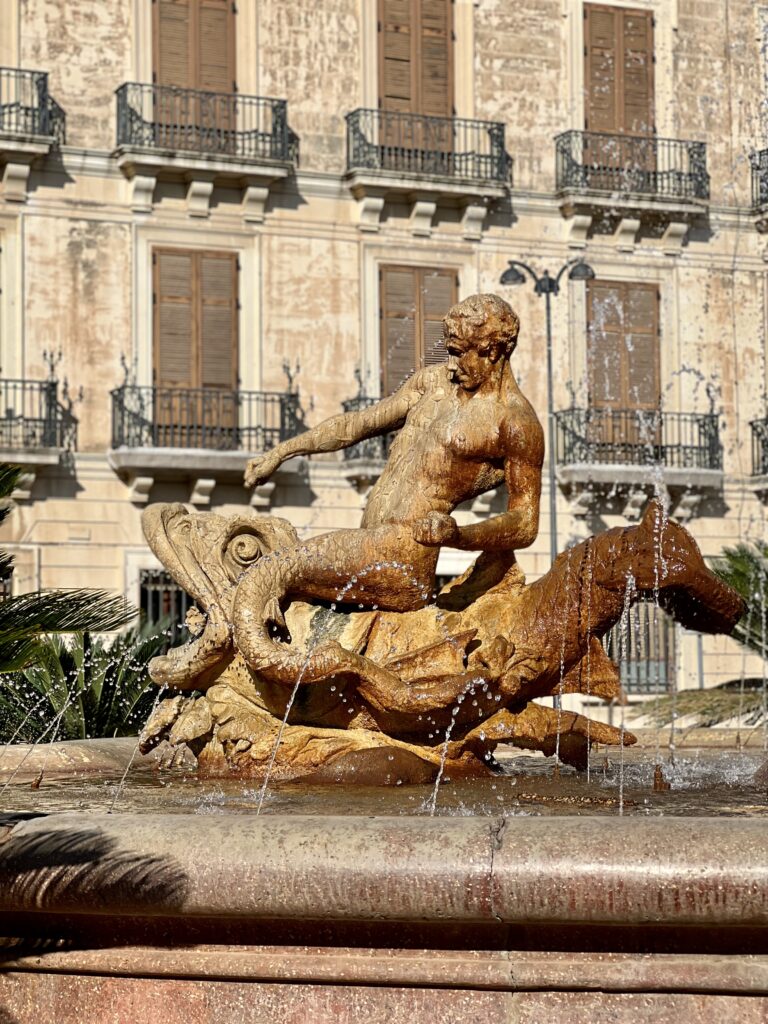
You can also walk to the mainland easily enough. But you can also get there by using the city buses or taking a taxi. Buses leave from the Piazza della Posta just over the bridge on Ortigia island.
You can also get around Syracuse on a guided biking tour.
3. Where To Stay in Syracuse
You’ll want to stay on or near the island of Ortigia, not mainland Syracuse.
The most elegant hotel is the Algila Ortigia Charme Hotel. It’s right one the waterfront and has air conditioned rooms with antique furnishings.
The Ortea Palace Luxury Hotel is housed in an Art Nouveau era building that was transformed into an elegant palace hotel.
You can also check out the Hotel Roma (next to the cathedral), Caportigia Boutique Hotel (with a rooftop terrace), and Domus Mariae (rooftop terrace and wellness center), all with excellent central locations.
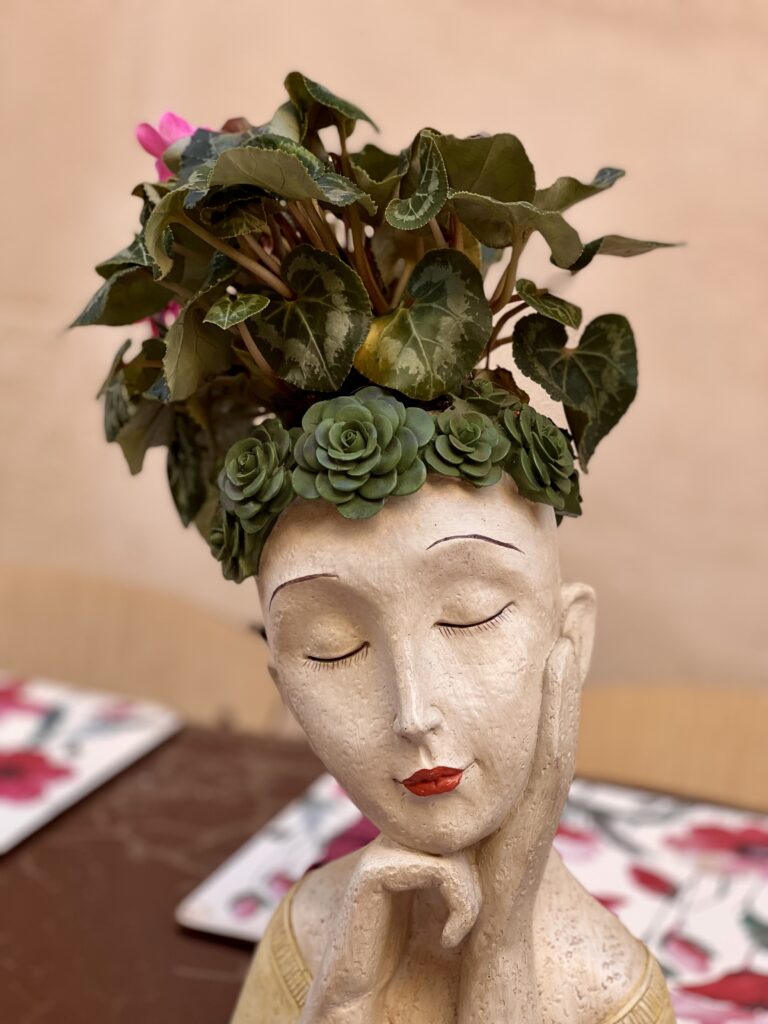
4. When To Visit Syracuse
Because of its temperate climate, Syracuse can be visited year round, with just a few cold weeks in winter. Summers, however, are very hot and crowded with tourists, so I would not recommend visiting then.
March through June and October are ideal times to visit. You’ll find temperatures in the 70s and 80s.
Try to avoid visiting Syracuse on a Monday. Most of the attractions are closed, except for the Archaeological Park.
If you love classical drama, come to Syracuse for its annual theater festival. It typically takes place during the months of May and June.
This festival celebrates the ancient Greek theatrical tradition in the historic setting of the ancient Greek Theater. You can see the great works of Sophocles and Aeschylus.
So that’s a wrap. I hope you’ve enjoyed my 2 days in Syracuse itinerary. You may enjoy these other Italy travel guides and resources:
- 10 Day Itinerary for Italy
- 10 Day Itinerary for Tuscany
- 10 Days In Southern Italy Itinerary
- 1 Week In Umbria Itinerary
- 35+ Historic Landmarks in Italy
- Tips for Visiting Italy
- 5 Day Itinerary for Rome
- 3 Day Itinerary for Rome
- 3 Day Itinerary for Florence
- 2 Day Itinerary for Venice
- 1 Day itinerary for Milan
Pin it for later.

